SIOBHAN
FALLON-HOGAN: ROOTED IN FAITH AND CNY


FALLON-HOGAN: ROOTED IN FAITH AND CNY


Don’t wait to get the care you need. When you visit the St. Joseph’s Health Cardiovascular Institute, you can expect the best. They’re rated high-performing in more heart procedures than all other area hospitals.*
You’ll be back home and feeling better in no time.
*U.S. News & World Report

Learn more at sjhsyr.org/cvi


It is a pleasure for me to welcome you to the inaugural issue of our diocesan magazine, SOLIS. The title of this new publication is significant for me because at my own ordination and installation as the Bishop of Syracuse, Timothy Cardinal Dolan spoke of me not only carrying a crozier (the shepherd’s staff) but also a lantern! A lantern that is the light of Christ and the truth of the Gospel. It is my hope and prayer that this new periodical of our diocese will be such a lantern as it brings the Gospel of Jesus Christ as it is lived out in our midst not only into the marketplace, but even more into our dwelling places. The word solis not only means sun, but also sunlight. It is our hope and prayer that this new medium for sharing our Catholic faith will radiate the light of Christ and his Church into people’s lives wherever they find themselves on life’s journey.
The word solis is used also to signify a person who plays or sings a solo. In his powerful Apostolic Exhortation, Evangelii Gaudium (On the Joy of the Gospel), Pope Francis states: “Every Christian is a missionary to the extent that he or she has encountered the love of God in Christ Jesus: We no longer say that we are ‘disciples’ and ‘missionaries’, but rather that we are always ‘missionary disciples.’” SOLIS can help foster this initiative on each of our parts by being a tool we can also hand on to others and foster another person’s encounter with the Gospel — the Good News of Jesus Christ.
I am so grateful to Deacon Tom Cuskey, editor, and all our associates at The Catholic Sun who have spearheaded this new venture in our diocese. Our sincere appreciation to all involved in the production and layout of the publication! May it light the way to Christ for those who encounter it!
In the Name of Jesus,

Most
Reverend
Douglas J. Lucia Bishop of Syracuse
Welcome! The concept of the magazine you are holding in your hands right now has been in the works for some time, and we hope the finished product is worthy of the effort. All of us on the Diocese of Syracuse communications team have strived to put our best foot forward with something new and exciting for readers throughout the seven-county region.
Solis is Latin for “sun” when used as a noun, and fittingly it is a product of The Catholic Sun team. The word is also the root in Latin adjectives like “solistimus,” describing something “most perfect.” We humbly do not assume perfection, but we do hold it as one of our goals: creating perfect vehicles to deliver the Good News of Jesus Christ in our mission of evangelization.
Unlike The Catholic Sun and our digital and social media products that feature news and information about timely events, SOLIS is intended to be of a different pace. Features of people and places that make a difference in our diocese will be our primary focus.
Our inaugural issue spotlights a native film star who vacations as a local summer Bible school teacher, childhood school chums who’ve grown into pilgrims, an Honor Flight veteran, and more. We hope you enjoy the stories we have told here. Relax and take your time with them. And if they spark a story idea of your own, please share it with us for future consideration. This is your magazine, too!
You have received this new product because you are a subscriber to The Catholic Sun, or because of your generous support of the diocesan Hope Appeal campaign. First and foremost, thank you!
Additionally, we hope you find SOLIS to be inspiring, entertaining, and faith filled. We also hope that you participate in the evangelistic mission and encourage others you know to share in the effort by supporting The Catholic Sun and Hope Appeal and joining in the Good News!
In Christ,
Deacon Tom Cuskey Editor-in-chief
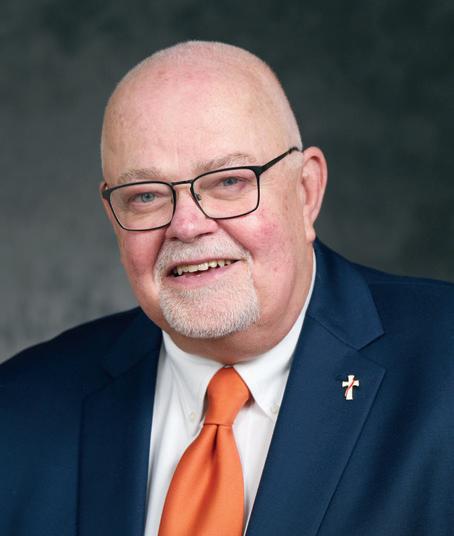




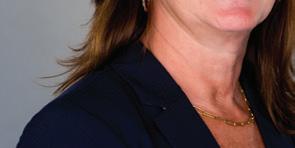




Exclusive healthcare partner of Syracuse
Athletics





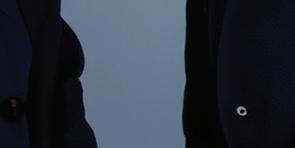

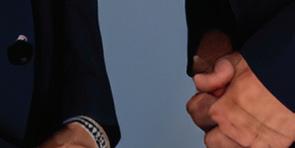









As professionals with deep roots in our community, we are proud of our commitment to the clients we serve and to the areas where we live and work. We look forward to helping educate, enlighten and empower our communities to achieve their business, social and public goals.






The Pluff Wealth Management Group
J. Daniel Pluff Managing Director – Financial Advisor Senior Portfolio Manager – Portfolio Focus 5786 Widewaters Parkway, Suite 2 Syracuse, NY 13214 (315) 423-1434
j.daniel.pluff@rbc.com us.rbcwm.com/pluffwmg
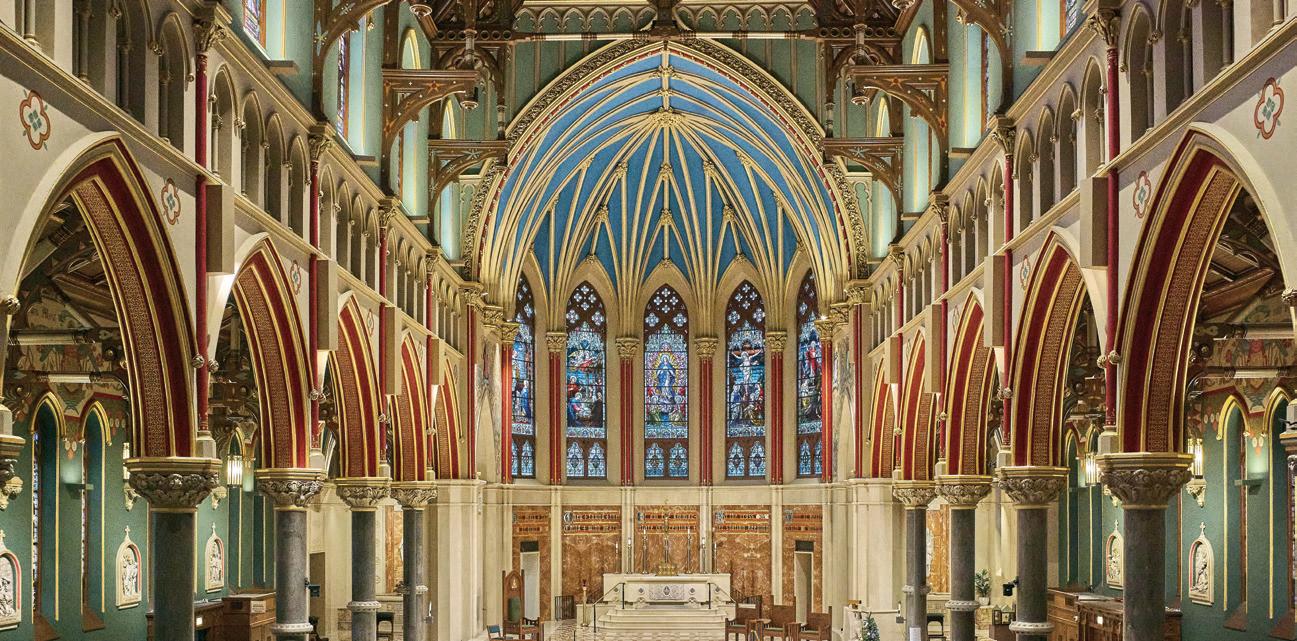



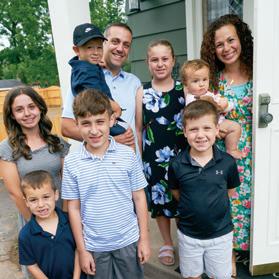
PRESIDENT AND PUBLISHER
Most Reverend Douglas J. Lucia
CHANCELLOR & DIRECTOR OF COMMUNICATIONS
Danielle Cummings
EDITOR
Deacon Tom Cuskey
ASSOCIATE EDITOR
Tami S. Scott
STAFF WRITER
Eileen Jevis
MAGAZINE DESIGNER
Colleen Kiefer/ Kiefer Creative
BOARD OF DIRECTORS VOLUNTEER
CREATIVE ADVISOR
Amy Bleier Long
GRAPHICS SUPPORT
Willie Putmon
ADVERTISING
Mark Klenz
Claire Dana/ Card Associates
CIRCULATION/OFFICE SUPPORT
Pamela Stepien
PHOTOGRAPHER
Charles Wainwright/ Wainwright Photography
SOLIS is a publication of The Catholic Sun, official newspaper of the Roman Catholic Diocese of Syracuse, NY, serving Broome, Chenango, Cortland, Madison, Oneida, Onondaga and Oswego counties.
SOLIS is direct mailed to subscribers of The Catholic Sun and supporters of the annual diocesan Hope Appeal campaign. Subscriptions are available for $26 annually by calling 315-422-8253.
ALL INQUIRIES: The Catholic Sun Diocese of Syracuse 240 East Onondaga St., Syracuse, NY 13202 (315) 422-8153
solis@thecatholicsun.com www.thecatholicsun.com
Office hours: 8:30 a.m. - 4:00 p.m., Mon-Fri.
The Catholic Sun is published by the Syracuse Catholic Press Association, Inc. SOLIS is made possible in large part thanks to a McDevitt Evangelization Grant. We are very grateful for this generous support.

Deacon Tom Cuskey is editor-in-chief of The Catholic Sun and has a media career that includes radio news, directory publishing, and 35 years in weekly community publications. Tom was ordained a permanent deacon in 2010 and worked in the deacon formation program for 11 years including time as director of the program. He is assigned to the linked parishes of Christ the King and Pope John XXIII in Liverpool.
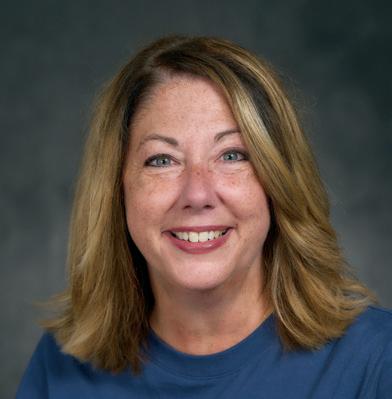
Tami S. Scott is the associate editor of The Catholic Sun. A Liverpool native, Tami is an award-winning writer and former editor with Scotsman Publications and Eagle Newspapers in Syracuse. She has contributed as a freelance writer to a number of media outlets and served as newsletter editor for Bishop Ludden Jr/Sr High School. She is a member of St. Augustine Church in Baldwinsville.
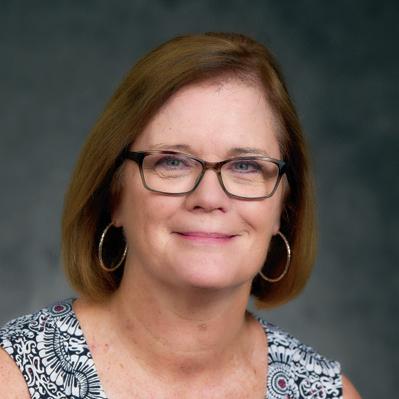
This is Eileen Jevis’s second stint with The Catholic Sun after serving as staff writer in the early 2000s. She covered the relocation of Mother Marianne Cope’s remains from Molokai to Syracuse in 2005. Upon retirement from University College of Syracuse University, Eileen returned to the Sun as a part-time contributor. Her multiple journalism awards include the Commander’s Award for Public Service from the U.S. Army. She worships at Holy Family Church in Fairmount.

Tom Maguire is an award-winning writer many times over and retired this year as associate editor of The Catholic Sun. Tom was a writer/reporter and copy editor for the Syracuse Post-Standard for more than 25 years among other journalistic experiences. His engaging, unique style in reporting on Central NY people of interest is fueled by his voracious appetite for studying the art of journalism.

Deacon Tom Picciano is a journalist with 45 years of experience in radio, television, print, and digital media. A graduate of St. John Fisher College in Rochester, Dc. Tom has been honored many times for his efforts, including reporter of the year by the Associated Press. He’s written a faith column for the Binghamton Press and Sun-Bulletin and has been a Catholic Sun contributor for the last 25 years. He was ordained in 2006.
You may wonder why you have received this edition of SOLIS magazine?
Luck had nothing to do with it, but gratitude does.
The first issues of SOLIS will be mailed to all paid-subscription members of The Catholic Sun family as well as all who contributed to the 2023 Hope Appeal campaign. It is through your support that the communications mission of evangelization is made possible.

Encourage others to join us: Subscribe to The Catholic Sun Online at https://thecatholicsun.com/subscribe/ info@thecatholicsun.com 315-422-8153
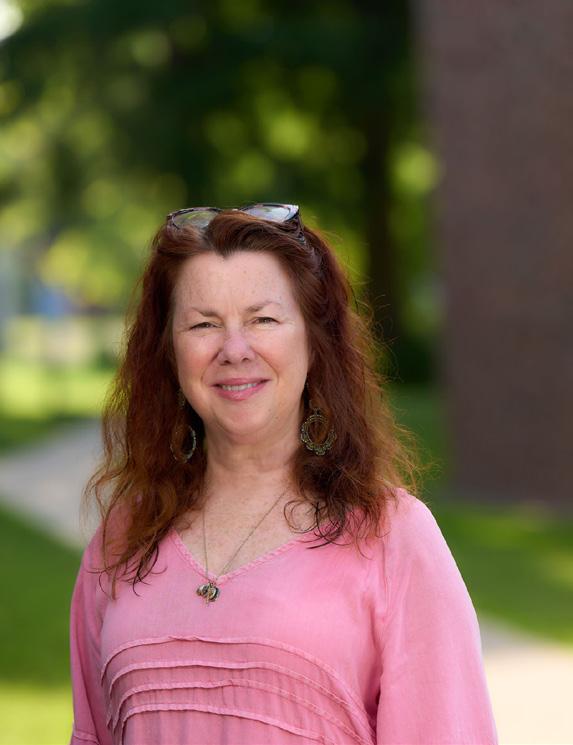
Give to the Hope Appeal Online at syracusediocese.org/hopeappeal bhoey@syrdio.org 315-472-0203
“TO
ALWAYS BE UNITED WITH JESUS, THIS IS MY LIFE PLAN.”
—CARLO ACUTIS

Pope Francis formally recognized a miracle attributed to the intercession of Blessed Carlo Acutis, a 15-year-old Italian teenager whose birth in 1991 will make him the first “Millennial” to become a saint. He is pictured in an undated photo.
Blessed Carlo Acutis will be proclaimed the Church’s first Millennial saint sometime during the Jubilee Year 2025. As we wait for the date to be announced, we can actively learn about the late Italian teen and his works as a devout Catholic who loved gaming and became a tech whiz.
Already referred to as “God’s influencer” and the “patron saint of the internet,” Acutis used his passion for programming to design a website that cataloged Eucharistic miracles from around the world. The miracles listed have all been approved by the Church. The website is www.carloacutis.com. Written in Italian, it can be translated into six other languages.
Blessed Carlo died of leukemia at age 15 in 2006. He is laid out at the Church of Santa Maria Maggiore, also known as the Sanctuary of the Spoliation, in Assisi, Italy. If you visit www.carloacutis.com/en/association, you will find more information on Blessed Carlo, including a brief background of his life, quotes he was known to say, prayers and more.
The 2025 Jubilee Year, themed “Pilgrims of Hope,” begins on Christmas Eve, December 24, 2024, and ends on January 6, 2026, the Feast Day of Epiphany.
“We must fan the flame of hope that has been given us, and help everyone to gain new strength and certainty by looking to the future with an open spirit, a trusting heart and far-sighted vision,” Pope Francis stated in his February 2022 letter announcing Jubilee 2025. Stay tuned to all things Jubilee 2025 by visiting the official website, iubilaeum2025.va/en.html, and downloading the iubilaeum25 app. There you’ll find the official prayer authored by Pope Francis, the meaning behind the logo, the significance behind the Opening and Closing of the Holy Doors during a Jubilee year, itineraries, pilgrim information, and even how to become a volunteer in Rome!
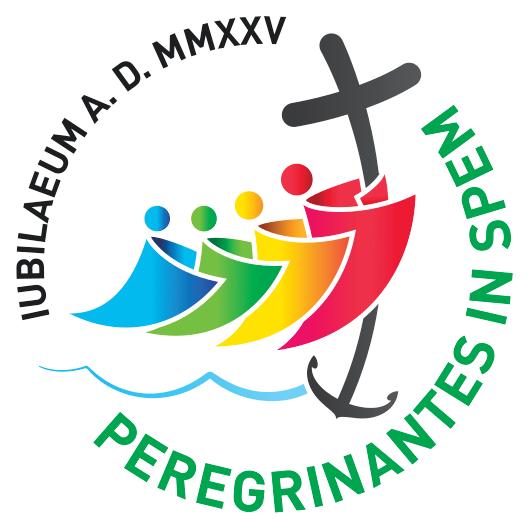

PHOTOS BY CHARLES WAINWRIGHT, DESCRIPTIONS CONTRIBUTED BY DAN FAY
CATHEDRAL OF THE IMMACULATE CONCEPTION is the “Mother Church” of the Diocese of Syracuse and the seat of Bishop Douglas J. Lucia. Originally constructed in 1874, the most recent restoration project was completed in August 2017.
1 A view of the interior of the Cathedral, showing the Sanctuary Apse that was added in 1903. An apse is a semicircular recess, typically at the end of a church or cathedral center aisle, which often houses the altar. The Altar and Ambo were relocated in 1986 in response to the changes of the Second Vatican Council. Toward
the back of the Apse are the Cathedra and Tabernacle. This High Gothic addition includes five large stained-glass windows depicting Mysteries of the Rosary.
2 The Gothic design of the Cathedral is shown with pointed arches that frame the Nave and “lancet” stainedglass windows.

3 Cathedra is Latin for “seat of the Bishop.” Bishop Lucia’s Cathedra was made by Stickley Furniture and installed as part of the restoration.
4 At the top of the Cathedra is a plaque with Bishop Lucia’s coat of arms. In addition to Bishop Lucia’s motto, In the Name of Jesus, half shows the symbols of the Diocese of Syracuse, the other half is specific to Bishop Lucia’s ministry.
5 To the right of the Sanctuary is a side aisle altar dedicated to the Holy Family. Above the altar is this rendering of the young Jesus alongside Mary and Joseph.


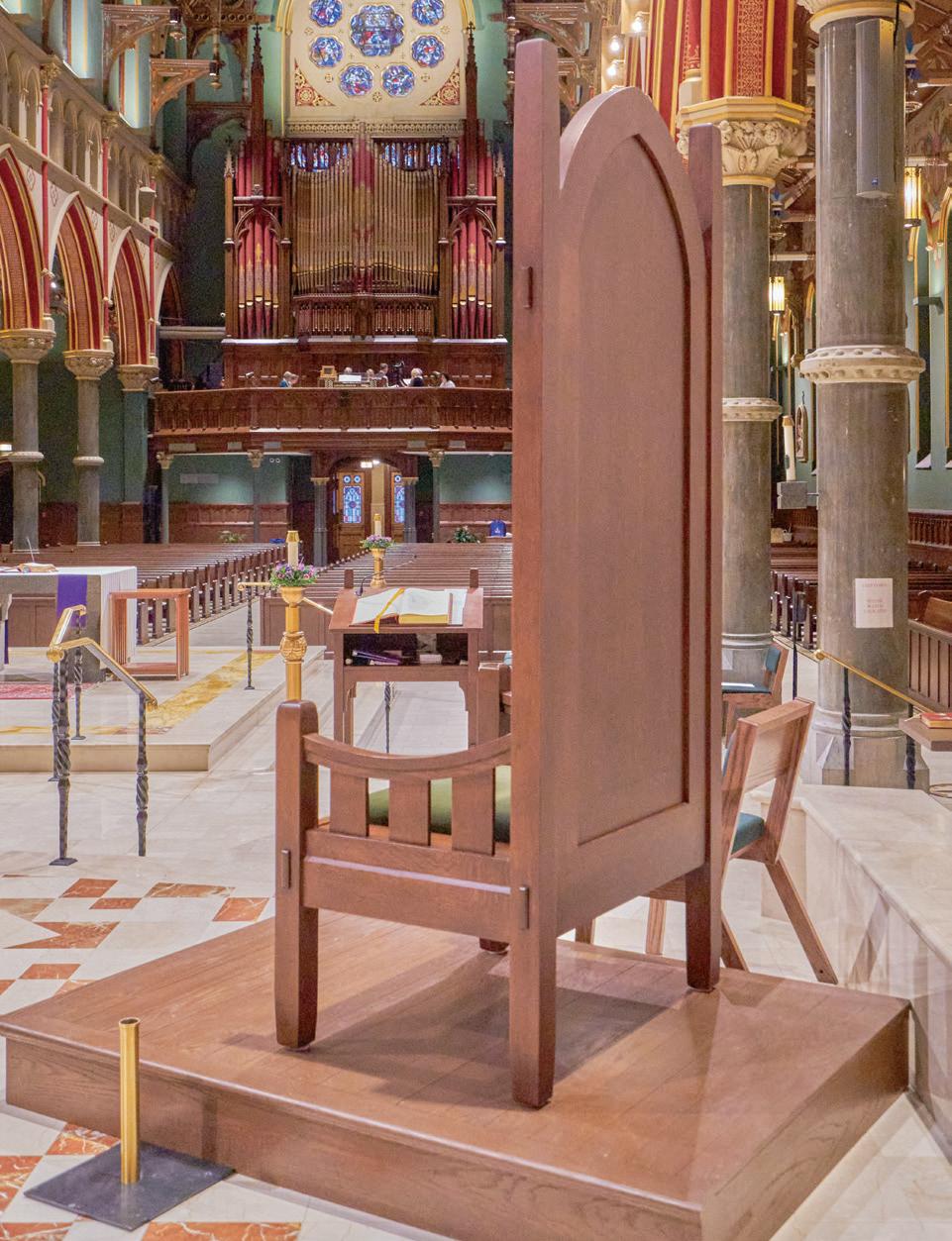
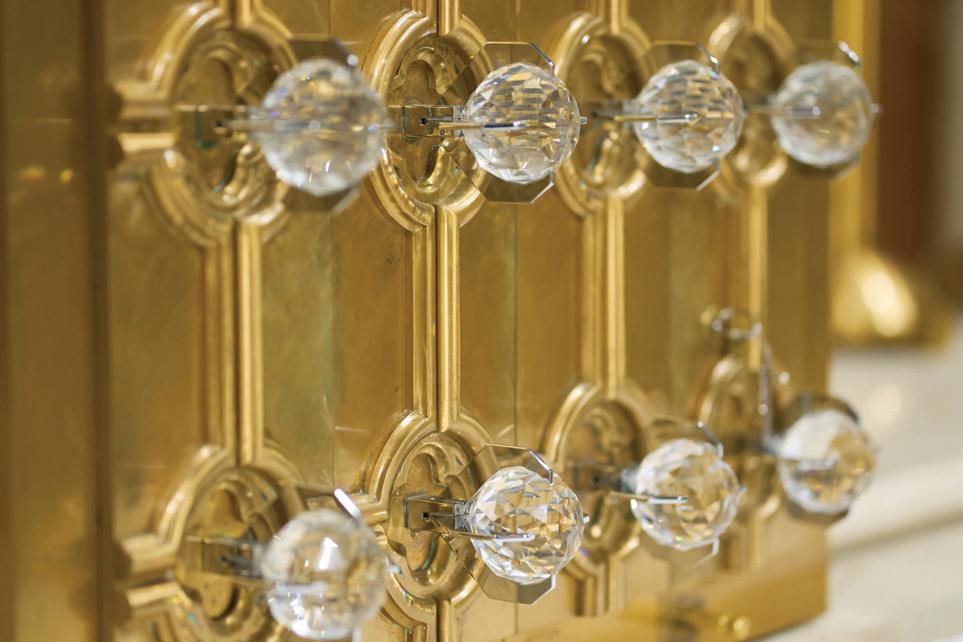
6 In the back of the Sanctuary Apse is the Marble Altar of Repose, which includes the Tabernacle. This area was restored as part of the recent project with marble steps reconstructed to allow access to the high altar.
7 Dominating the rear wall of the Cathedral is the magnificent Roosevelt Organ, which was installed in 1892, consists of 3,000 pipes, and was designed specifically for the Cathedral. This wonderful instrument, lovingly maintained, greatly enhances the music ministry at Cathedral.

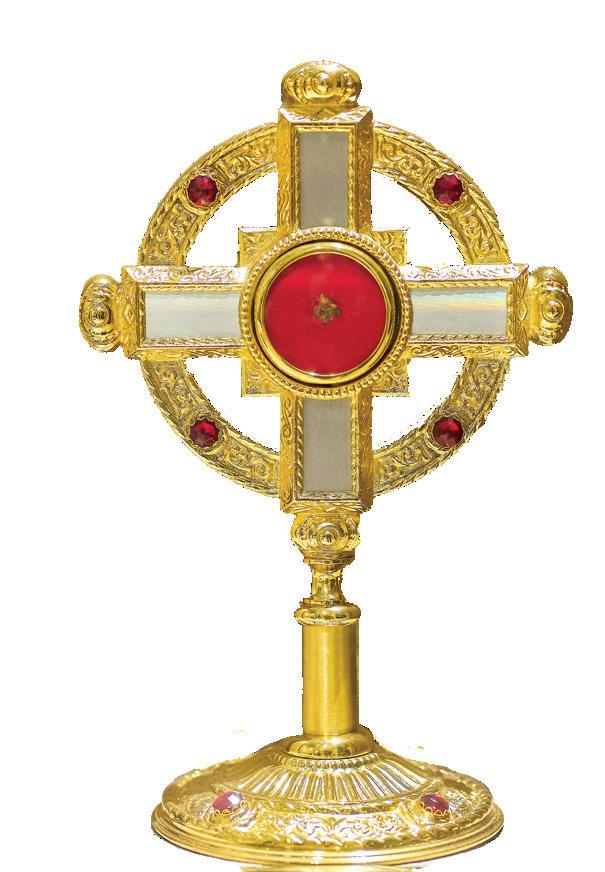
8 Located in the former Baptismal area is a Shrine to Our Lady. The walls of this room are covered with beautiful mosaic images. A sculpture of Mary, seated, as an older woman is located in the center along with space for private devotion.
9 Adjacent to the Sacred Heart of Jesus side altar is a relic of St. Marianne Cope, provided by the Sisters of St. Francis, and a beautiful mosaic of St. Marianne Cope.

By Tom Maguire
It’s a good thing they hadn’t taken a vow of silence.
Nuns in the convent took to howling when their team from the “dog-eat-dog” Parochial League competed in the biggest basketball game of 1967. In the league’s heyday, even the cheerleaders knelt down and prayed before a game, as a photo attests.

So break out the salve and keep the whole first-aid kit on standby when you read about the rugged hoopsters flying all over the courts in the five-volume boxed set “Floor Burns,” by M.C. Antil, a Chicago-based writer who graduated from Christian Brothers Academy in Syracuse.
Other injuries are common to basketball players, too, but certainly “Foot Blisters” is less catchy than “Floor Burns” as a title. “Before we get to foot blisters,” Antil said, “we probably would have been through chipped teeth, you know, black eyes and then maybe foot blisters.” And that’s just the players. There are Parochial League and pro refs in the book (remember the Syracuse Nationals?) who may have avoided floor burns but risked the full-body burn in the place where a dubious ref’s whistle melts in his mouth.
Hoop historian Antil weaves in a story about the surrounding world of the city and the country in the 1960s, and about the personalities and heroes of the day, including the “remarkable Monsignor Charles Brady,” who inspired the present-day Brady Faith Center on the Southwest side.
“Floor Burns,” the author said, is “truly about the history of Syracuse, including the history of the Catholic Church in Syracuse as told through the prism of a basketball game.” The photos will have readers salivating for the old days, such as the image of Fish Cove, which opened in 1948 in Westvale Plaza and “quickly became a favorite of generations of Sacred Heart basketball fans and families.”
Famous visitors to Syracuse included NBA stars like Wilt Chamberlain and Bill Russell. When they “wanted to unwind after a game against the always-physical and always-tough Syracuse Nats,” Antil writes, “they’d leave the War Memorial via State Street and walk a block south to the Embassy [Lounge], where they knew they could grab a quick bite while listening to some very cool (or very hot) jazz, depending on who was playing.”
In the “Overtime” volume, the author tries to capture “stories that had been told and retold for decades — long after, in fact, that unique little parish-based league had faded to memory. …
“Everything you’ve just read — the final All City game, the death of the 15th Ward [to make way for the building of Route 81], the racial tension, the collision of the two once-parallel worlds, the impact of Vatican II, the rapid demise of the local economy, the white flight, all of it — stemmed from that one simple … pursuit, to tell the story.”
Antil said the old Parochial League had 10 K–12 schools, all of them neighborhood based, and consequently, ethnicity based: Italian, German, Ukrainian, Polish, and Irish,

The benchwarmer is clutch with a pen.
Author M.C. Antil, who was honored by Christian Brothers Academy but not for basketball, recalled speaking to the daughter of one of the coaches he writes about in “Floor Burns,” his five-volume tale of the old Parochial League.
She told Antil that he brought her dad to life.
“I said, ‘Well, you know what? I’m a good enough basketball player to play on teams, but I never started. … I just sat there on the bench. And what I thought was the worst thing that could have ever happened to me as a high school kid — not playing — turned out to be the best thing. It’s like God had a plan for me.’”

An 11-year plan — his total time researching and writing the book. “Painstaking conversations, little things,” he said. He “was just doggedly looking for more and more and more.” He turned out a “history of Syracuse, including the history of the Catholic Church in Syracuse, as told through the prism of” the 1967 All-City Championship game between Sacred Heart Academy and Corcoran High School.
So readers get a combined game story, celebration and lamentation — based largely on the Syracuse of the 1960s. “It’s been a spiritual journey,” he said. The extraordinarily detailed book will reside in the archives of the Diocese of Syracuse; it is also sold at https://order.floorburnsbook.com/.
Another CBA grad, Father John C. Schopfer, Weekend Associate at the Cathedral of the Immaculate Conception in Syracuse, is reading the book. He said “Floor Burns” is “so much more than basketball,” such as the immigrant experience and what the Church meant, and “social life and struggles, good and bad, in Syracuse.” The book, he said, “uses ordinary events to tell a much greater story.”
Readers of “Floor Burns” might wonder where the author’s doggedness comes from? How could this Chicago-based writer have constructed a tale of basketball, priests, bishops, nuns, race relations, and the demise of the mostly Black section of the city (to make way for Route 81)?
Well, for one thing, he had a 100 percent Catholic education. Michael Charles (reduced to “M.C.” because his dad and his grandfather were also named “Mike”) Antil was born in Syracuse but his family lived for a time in Ohio where he attended Catholic schools. Back in Syracuse, he attended elementary school at St. Charles. Then came CBA in DeWitt (“just another scrappy, streaky undersized shooting guard from the West Side of Syracuse,” he says online) and St. John Fisher College in Rochester.
In 2019, Antil ’72, was among the winners (including Father Schopfer ’61,) of CBA Distinguished Alumni Awards. CBA reported that Antil has “over 30 years of experience as a marketer and communications strategist in television, professional sports, and other highly competitive industries.
He began his career in the front office of the Chicago White Sox, learning the business of baseball from the ground up. When the White Sox were sold, he began a career in the cable television industry where he spent 21 years in various roles, eventually becoming director of corporate communications for ESPN. He left ESPN in 2001 to begin his writing career with the column M.C. Antil’s CableFolks, profiling industry executives and giving his readers a combination of news-making achievements and personal backstory.
Antil had worked on “Floor Burns” from 2003 to about 2007 but then “put it in the closet.”
“And then in ’14,” he said, “I got throat cancer. And I said, You know what? If I get through this, I gotta finish this book because if I don’t tell this story, nobody’s gonna tell this story.” So he got serious and worked on the book from 2014 to 2021.
“This whole journey has gotten me much closer to being a practicing Catholic again,” he said, “because I was a lapsed Catholic. But I have a clear understanding of the power of Catholicism now, in a way that I didn’t when I first started this book.”
The author recalled catching COVID-19 and experiencing “these incredibly high spikes in blood pressure. … They got my blood pressure back under control. But the thing was, I’m in back of the ambulance. And the only thing I thought, the only thing I thought: Thank God I finished that book.”
for example. On Friday nights, he said, these kids would play basketball games that were like a “cross between ‘Hoosiers’ and ‘Braveheart.’ It was clan warfare.”
There were eight All City Championships, concluding in 1966-67. “In the ‘1st Quarter’ volume,” Antil explained, “the annual All City Championship … was the brainchild of a Catholic priest who served as Bishop [Walter] Foery’s right-hand man for all youth-related activities. The showdown, played every March at the Onondaga County War Memorial, pitted the winner of the Syracuse City League against the winner of the Parochial League.”
If the Catholic schools were clans in the ’60s, then the coaches were the chieftains. For example, St. John the Evangelist coach Robert “Bobby” Felasco “was an absolute force of nature on the sidelines. A relatively short man … with a moon-shaped face, a flat-top haircut and a square jaw that shifted back and forth as he relentlessly worked a piece of gum or barked out orders.”
Bespectacled Sacred Heart coach Billy Ewaniszyk “was a ham by nature and relished the spotlight; in fact, for a brief time he was part of a comedy team that played the Catskills.” Corcoran Cougars coach Ken Huffman was even-tempered and mild-mannered. After all, the author notes, his players “didn’t call him ‘Old Stoneface’ for nothing.”
Certain refs apparently noticed the differences in skin color between teams in those days. And when Huffman’s Cougars faced Felasco’s Eagles in the 1966 All City game, Antil writes, “Huffman didn’t tell his boys that cold March night … that if the game remained tight, close calls
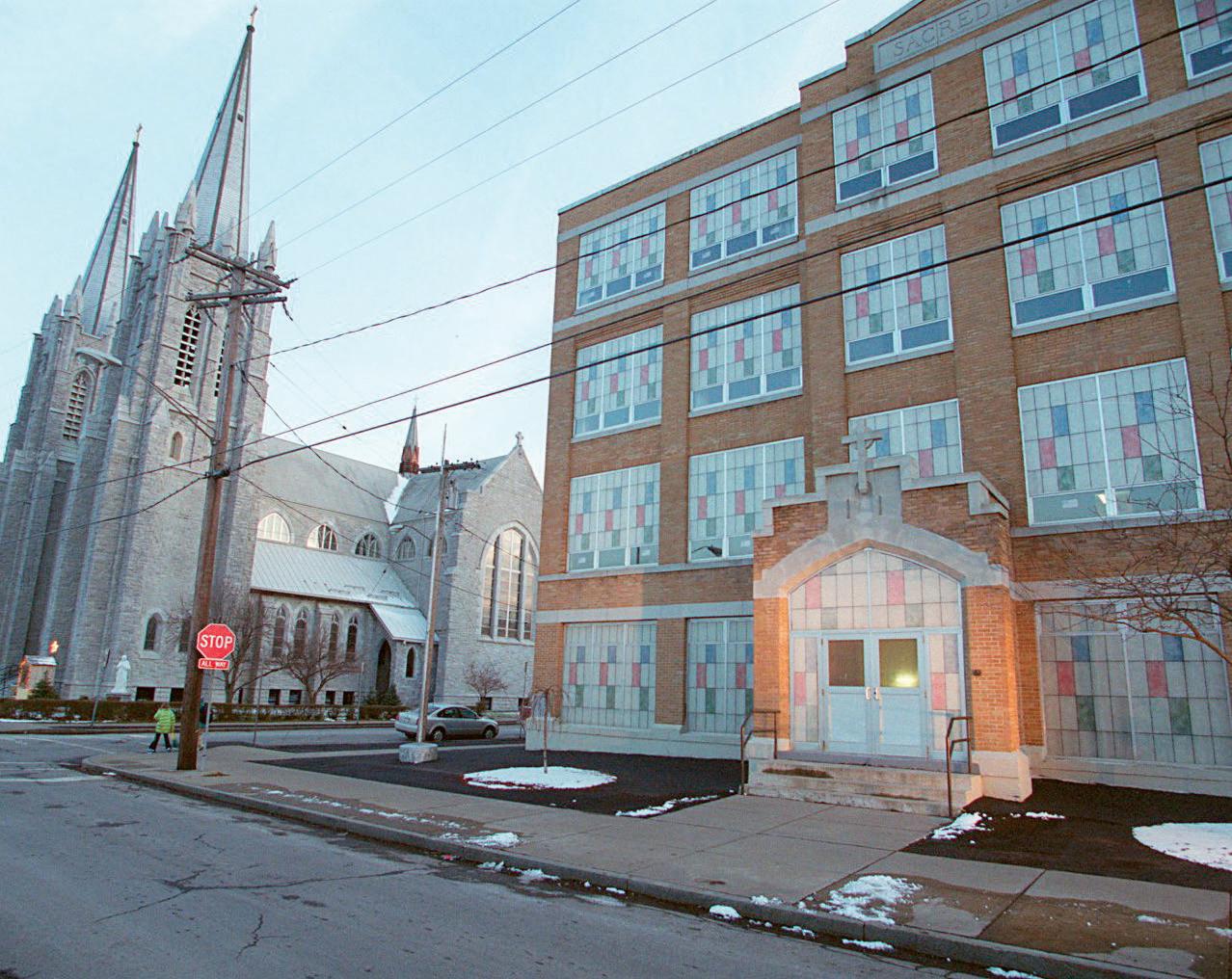
were not going to go their way. It was a simple fact of life and a cold, hard truth for any Black player during the eight-year run of the All City game. Certain refs were never going to give them the benefit of the doubt, much less a close call.”
The final All City Championship game on March 10, 1967, featured on the public-school side Huffman’s mostly Black Corcoran squad, which was “shockingly slender and almost comically undersized.” But the Cougars were quick and they had a “generational, perhaps historically great backcourt. And, yes, every one of their five starters, seemingly, could run until the cows came home.”
“But Sacred Heart,” Antil writes, “was not only significantly bigger and stronger, in a couple of years four of the five starters would prove to be so good they’d be playing college ball.”
“This one game’s dramatic conclusion,” Antil writes, “might

have been the exclamation point on Syracuse’s golden age.”
That ’67 game was so big, the barber shop near Sacred Heart offered half-price “All City Haircuts,” Antil writes. One assumes haircuts were not the concern of the nuns, who directed their devotions toward their Heartsmen:
“Before the All City game, the nuns of Sacred Heart — who never, ever missed a home game (but who, for some reason, did not travel to away ones), spent the entire All City
week saying seven days’ worth of a nine-day novena for their boys … those beloved sons of Poland. (Well, okay. Nine sons of Poland, one Czech, one German and one Irishman, but who’s counting?)”
With the game finally underway, Antil describes the scene in the Sacred Heart convent: “Two of the older nuns seated around their big old AM/FM cabinet console had now gotten down on their knees in prayer, as had the young nun up in her bedroom, the one who had been sitting on the edge of her bed, with her reel-to-reel machine continuing to whir as it captured the drama being brought to life so vividly by [announcer] Jack Morse.”
“In the background,” Antil writes of the first-half scene, “those listening to Morse’s voice at home or in the car … could hear the faint echoes of the Hearts cheerleaders, all ten of whom were … at center court performing one of their well-practiced routines, their white sweaters and maroonand-white pom-poms shimmering against a dark sea of wool and drab winter hues.”
Corcoran led 60-56 with just 1:21 remaining in the fourth quarter. But then Sacred Heart sank a free throw and made an “eight-foot prayer” of a bank shot. Antil describes the scene in the convent: The young nun upstairs began to sob tears of joy.
“Meanwhile, on the first floor, her fellow nuns howled with delight as Morse barked out the joyous news of [Joey] Zaganczyk’s bank shot, some springing up off their knees to dance a little impromptu jig, Rosary beads jangling. One of them, an otherwise quiet one, simply fell on the floor face-first, as if overcome with rapture or, maybe, a heart attack.”
Who was that clutch kid?
One side — we won’t spoil it for you — won the game with a shot by a kid who had a “penchant for ill-advised shots and moments of untethered and almost comically misdirected passion.” He made a “slightly awkward-looking push shot from the corner, just to the left of his own bench.” Did the nuns backslide
into silence? Go berserk? Well, there were tears of a certain kind; read page 61 of the “4th Quarter.”
“Floor Burns” also includes other diocesan notables of that era.
Father Casimir Krysiak served as Sacred Heart’s athletic director for a decade. “He brought a missionarylike zeal for protecting the rights and furthering the reputation of Poles throughout the land, starting with

those in his adopted hometown of Syracuse.” Sacred Heart’s Sister Mary Judith “was nothing if not strong willed and as tough as barbed wire.” Sacred Heart Msgr. Casimir Piejda “always took it upon himself to deliver each child’s grades personally, often letting his eyes linger over the report cards of the basketball players and cheerleaders.”
Msgr. Brady also took a personal approach in his ministry in “his beloved 15th Ward,” as the “2nd Quarter” notes. Antil’s view of Msgr. Brady jibed with Auxiliary Bishop Thomas Costello’s comments about him in The Catholic Sun in 2015:
“He was ordained in 1930. He was stationed at St. John’s in Utica then Most Holy Rosary here in Syracuse. He volunteered for [military] chaplaincy and was accepted. By luck, the unit to which he was assigned was a medical unit in the South Pacific, and it just happened that the vast majority, if not all, of the members of that unit were Black. I’m sure he had [awareness] before that, but this really focused him. When he came home and the war was over, he asked Bishop Foery for permission to work in the inner city. He was called a city missioner. Bishop Foery, God bless him, gave him that permission.
“So he began working among the poor people in the 15th Ward, as it was known then. It has since become an Urban Renewal area and it’s pretty vacant over there now, but he was on the streets and in people’s homes.”
Msgr. Brady, Bishop Costello, and Msgr. Charles Fahey all were youngish priests back in the day, Antil said:
“Brady was just back from World War II, he’s more of a veteran and he sort of influenced Tom Costello, Chuck Fahey, all these guys who grew up to become Catholic leaders in this area.”
The leaders at St. Lucy’s Academy strove to turn students into public speakers, and basketball stardom earned no dispensation. One of them was the handsome, gifted Ormond Spencer, a “high-flying circus act from Syracuse’s 15th Ward.”
Ormie, as he was known, spent his first three years as a Parochial Leaguer as one of only a handful of Black faces in a sea of white Irish and Italian ones, an ethnic and psychological reality that caused him to grow more and more terrified at the mere thought of having to get up in front of others to speak.

But as a senior in December 1953, Ormie delivered an oration as pure as his basketball ability, and Sister Mary Gabriel sent it to The PostStandard, which printed it on the cover of the sports section.
Antil says this is how it read:
By Ormond Spencer St. Lucy’s Academy
Play the game hard, play it to win, but above all play it fair. These should be the first words that American boys and girls hear and they are words that should stick from childhood to old age.
Sportsmen are judged not by appearance, but by performance. We should enjoy victory and learn from defeat. There are no shortcuts or angles to be played, only one’s ability to be proved. This ability is the ability to produce better than the next person, the ability to make yesterday’s records history, and the ability to make today’s records a challenge to overcome tomorrow.
On the basketball floor, in the office, on the football field, in the home, hard-fought competition with fair play has been the backbone of America.
But even more than individual achievement in sports, is the allimportant team play, which springs from trust and respect of the other fellow. The sense of responsibility and co-operation created by team play extends from youth to adulthood. So, let this be your standard in any chosen field: play the game hard, play it to win, but above all, play it fair.


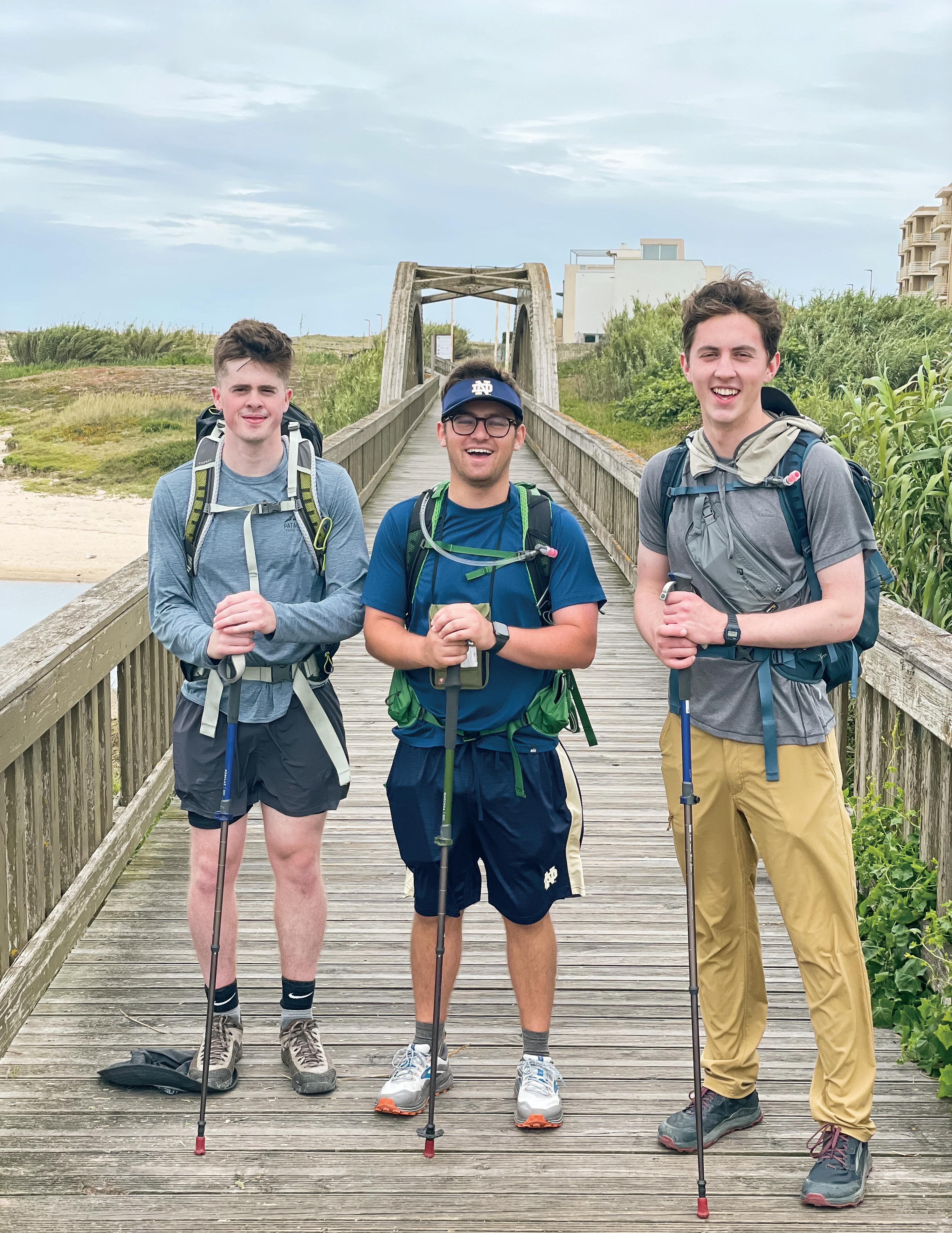

By Deacon Tom Picciano
Cousins Leo Gallagher and Michael Martin met Thomas Davis in kindergarten at St. Thomas Aquinas School in Binghamton. Their journey of friendship carried them through St. James School, then Seton Catholic Central High School, where they graduated in 2018.
In high school they learned of a pilgrimage called Camino de Santiago (The Way of St. James). The three completed this journey in Portugal and Spain in June and July 2022.
“We watched the movie, ‘The Way’ with Martin Sheen (which is about the Camino) in theology class while at Seton Catholic Central, Martin said. “Ever since then it’s been something we’ve talked about doing together.”
“That is where the seed was planted,” Gallagher said. “For me, the combination of adventure and spirituality were the two aspects that I would say most prompted me to go on this journey.”
Davis suggested to the others that the time was right, as he’d completed his studies at Notre Dame.
“The gap between graduation and employment presented the perfect pause to have the flexibility and freedom to do something for my heart rather than my resume,” Davis said.
“Instead of using the break time to learn a new skill or feel productive, my heart was pushing me towards pilgrimage, a time for reflection, friendship, and prayer,” he added.
Though they had more time allotted, they finished their journey in about a dozen days. It started in Portugal near the coast, then moved inland. “The journey ended up being much harder than expected,” Gallagher said. “The terrain became quite mountainous. We walked a lot of the time on cobblestone roads, which did no favors to the soles of your feet. One day we climbed 440 meters (1,444 feet) in elevation over the course of just three kilometers (1.8 miles).”

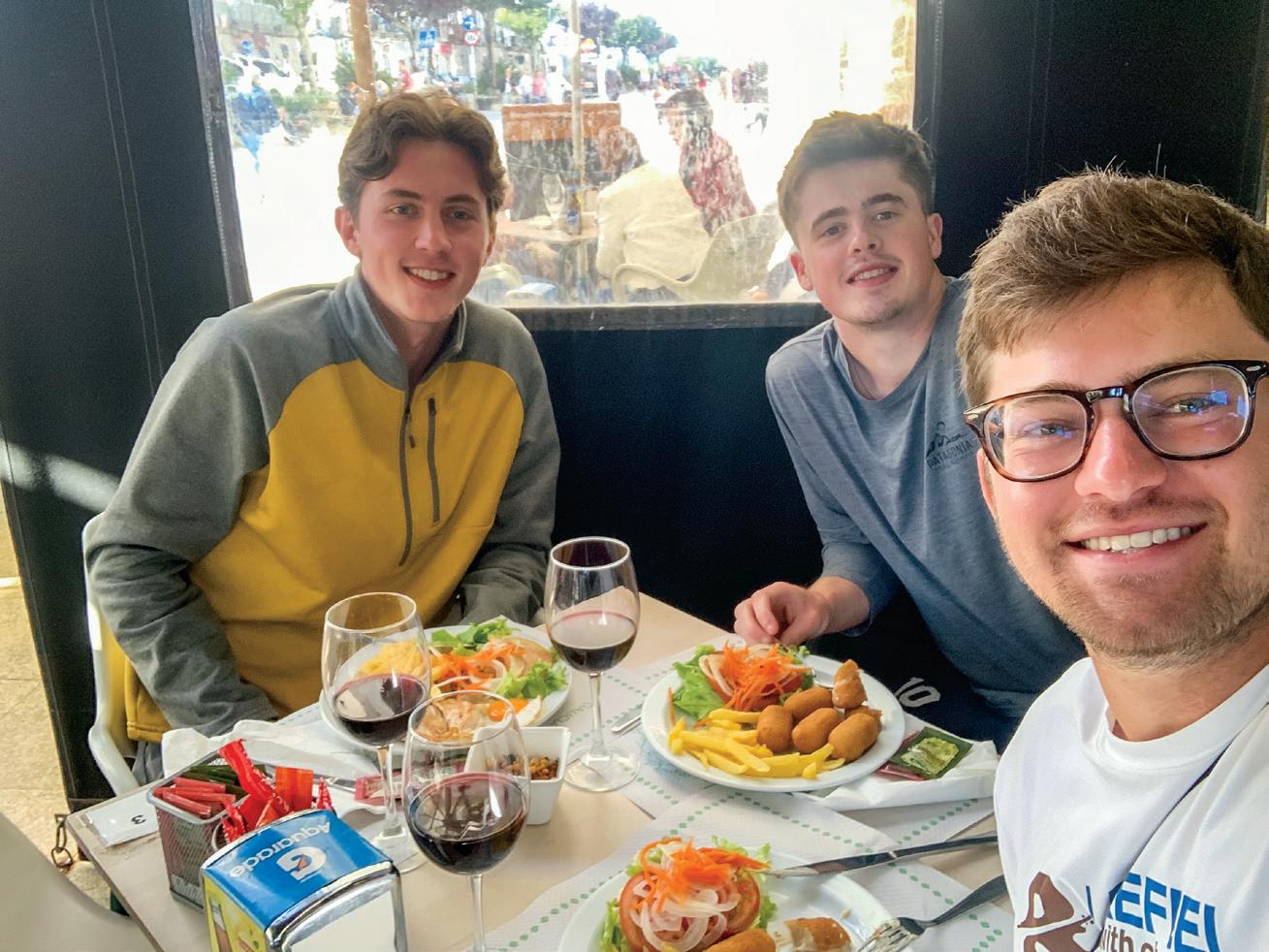
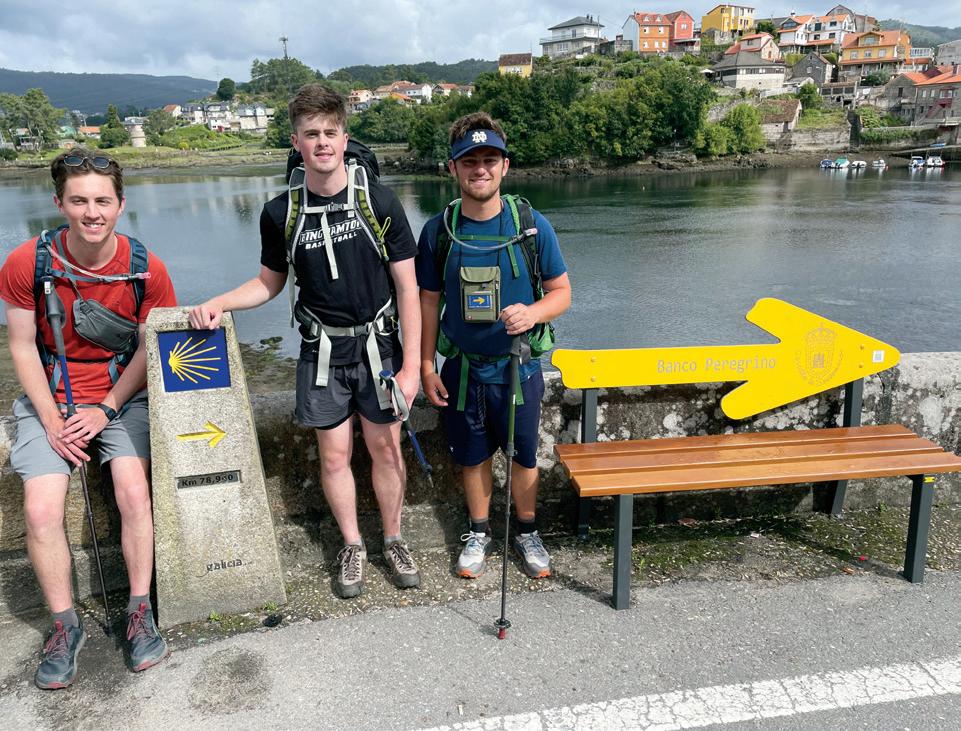
“There were some very taxing days. Unfortunately, I had some blisters develop on day two that were a bother throughout the rest of the pilgrimage,” Davis said. “We encountered some very steep uphill and downhill stretches. They were tiring and painful, but in the moment and even looking back at it now, I really enjoyed the challenge. During the tougher stretches, I relied on prayer and conversation with the guys to make it through.”
Martin noted the need to be adaptable.
“Some days were almost entirely uphill, others we were on dirt paths in the forests, others we were walking through big cities, so we got a lot of good variety. One day we had torrential downpours,” he said.
They completed their journey before the worst of a European heatwave, but they stayed hydrated, sometimes with water from natural springs.
The three stayed with other pilgrims in hostels along the way. Each day, they’d leave by 7:30 a.m. and complete about five miles before stopping to grab an espresso and croissant. More walking would follow, then a stop for lunch in a village. By 5 p.m., they’d check into another hostel. Later, they would have a “pilgrim menu” dinner and go to bed around 10 p.m.
The men would see some of the same hikers each day on the way including some from Denmark, Germany, the Netherlands, and a man from Ireland who they befriended the day they reached the end of the journey.
“We did not see too many Americans, but there was a large family from Washington, D.C. that came with uncles, cousins, friends, and their 82-year-old grandmother. Whenever she started catching up to us, we knew we had to pick up the pace,” Martin said.
“When you finally reach Santiago, you see so many of the people that you met along the way,” Gallagher said. “Whether you spoke personally with them or not you feel very connected with them and you share in the accomplishment of completing this journey.”
“The simplicity of each day and the peace of walking through amazing scenery allowed me to see God in a
“We encountered some very steep uphill and downhill stretches. They were tiring and painful, but in the moment, and even looking back at it now, I really enjoyed the challenge. During the tougher stretches, I relied on prayer and conversation with the guys to make it through.”
—THOMAS DAVIS

different light than the hectic fast-paced lifestyle at home,” Gallagher added. “You see God in the people you meet, in nature, and in yourself — in a clearer light.”
Davis remembered talking to the others as well as times of silence as they hiked along.
“I used this time for prayer of petition as well as gratitude for the many blessings in my life. As I walked, I realized that I was called to walk the Way with a special focus on gratitude for the many blessings I have: friendships at home and Notre Dame, my health, my parents and family, my new career, etc.,” he said.
“I went into the trip half expecting a monumental moment where I’m struck by light and have some amazing sign of faith. But as you’re walking, you are preoccupied by making sure you are headed in the right direction, the pains and aches in your legs, and trying not to think about how hungry you are,” Martin said.
Walong a
path while

hen Martin got home, he reflected on the good moments, people he met, random details, and being thankful.
“When you stop and think about the fact you just walked 200 miles, suddenly other things don’t seem as hard. And even with the difficult moments in life, you know that you just need to have strength, and eventually you will get through it,” he said.
Notre Dame graduate Davis is a legal support analyst. Gallagher received his MBA from Binghamton University. Martin returned to Binghamton University, where he earned his undergraduate degree and has begun work on his master’s.
To read blog posts detailing most of the trio’s journey as they made it, visit https://caminodetresamigos.blogspot.com






Discover the call to lay ministry through our Love of Jesus
Serve others
Learn about our Catholic faith
Grow as disciples
To learn more about Formation for Ministry, scan the QR code or visit us online at: syracusediocese.org/formation-for-ministry


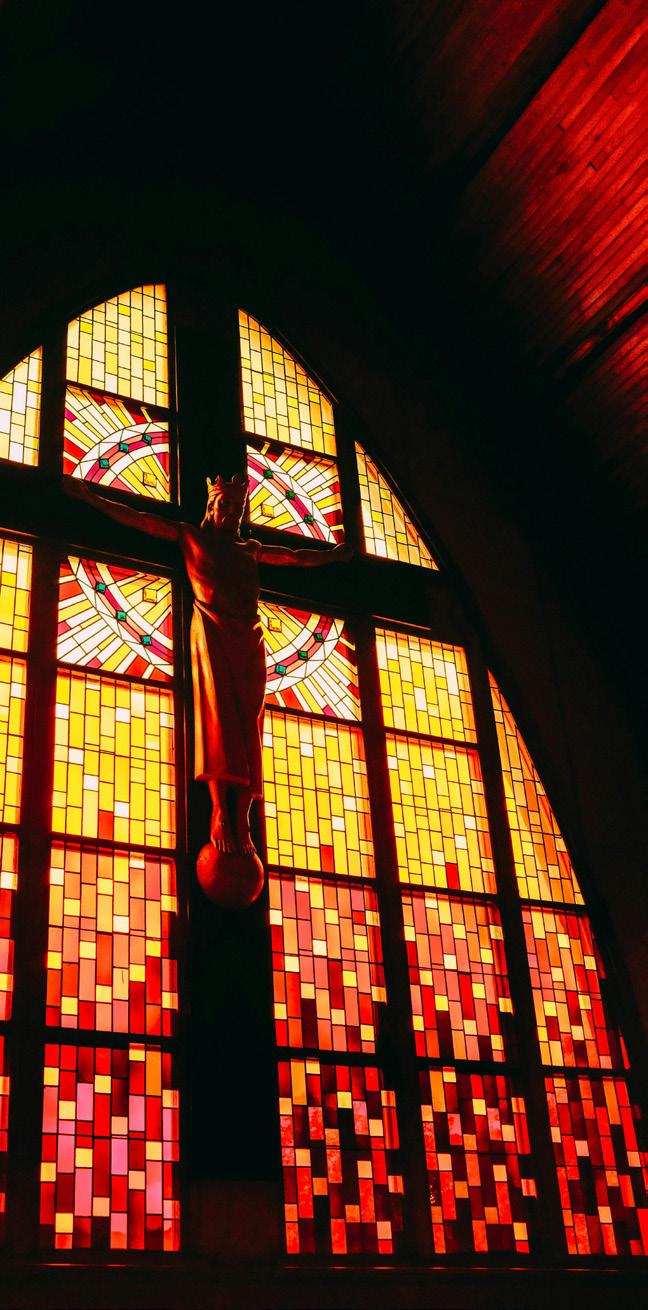
Fisherman’s Club - Vocation Visits to Newman Communities Friday, September 27th, SUNY Binghamton • Thursday, October 24th, SUNY Oswego Wednesday, November 13th, SUNY Cortland • Wednesday, February 12th, Colgate University • Thursday, March 20th, Syracuse University
Saint Andrew Dinner Project • Sunday, November 17th
New York State Discernment Retreat • Thursday, January 9th through Saturday, January 11th at the Good News Center in Utica
Diocesan Altar Server Celebration • Sunday, February 2nd at the Cathedral
World Marriage Day • Weekend of February 8/9
Fisherman’s Club Summer Cookout • Tuesday, May 27th at Saint Patrick’s in Oneida
Holy Hour for Vocations with Bishop Lucia for World Day of Prayer for Vocations • Monday, May 12th at 5:30pm at the Cathedral
Called By Name Program • Weekend of May 17/18
By Deacon Tom Cuskey

Cazenovia native Siobhan Fallon-Hogan wears many hats — actor, writer, and producer — all while staying deeply connected to her faith and community. Known for her involvement with the “Jesus Loves Me Summer St. James Bible Camp” this past July, SOLIS caught up with the star to discuss how her Catholic upbringing continues to shape her life, family, and flourishing career.

You know her. You have seen her on Saturday Night Live, in films like Forrest Gump and Men in Black and as a guest star in television programs. If you live in Cazenovia, you may have seen her at Sunday Mass at St. James Church.
Siobhan Fallon-Hogan is a star: actor, writer, producer. She uses those skills in her successful film, stage, and television career… and as the force behind the “Jesus Loves Me Summer St. James Bible Camp” which took place the week of July 15 this past summer.
SOLIS caught up with Fallon-Hogan on the opening day of the camp for some photos and fun to round out an earlier interview about her faith, family, and career.
Her parents, William and Jane Eagan Fallon, were both Syracuse natives; her father attended the downtown Cathedral School (and current home of The Catholic Sun) and attended Le Moyne College. Her maternal grandfather was one of the founders of the Syracuse-based Jesuit college. Siobhan graduated from Le Moyne in 1983 and went on to earn a Master of Fine Arts from Catholic University in Washington, D.C.
Her parents were “educated in the Catholic Church and passed that down to us,” she said.
“We were very active in the church … it was a big part of our lives.”
Her parents moved the family to Cazenovia — “to the ‘country,’” she laughed — when Siobhan was in seventh grade. “We would go out for Bible camp every summer.” Then, the church was a “small, beautiful church” that was eventually replaced with the larger church that stands
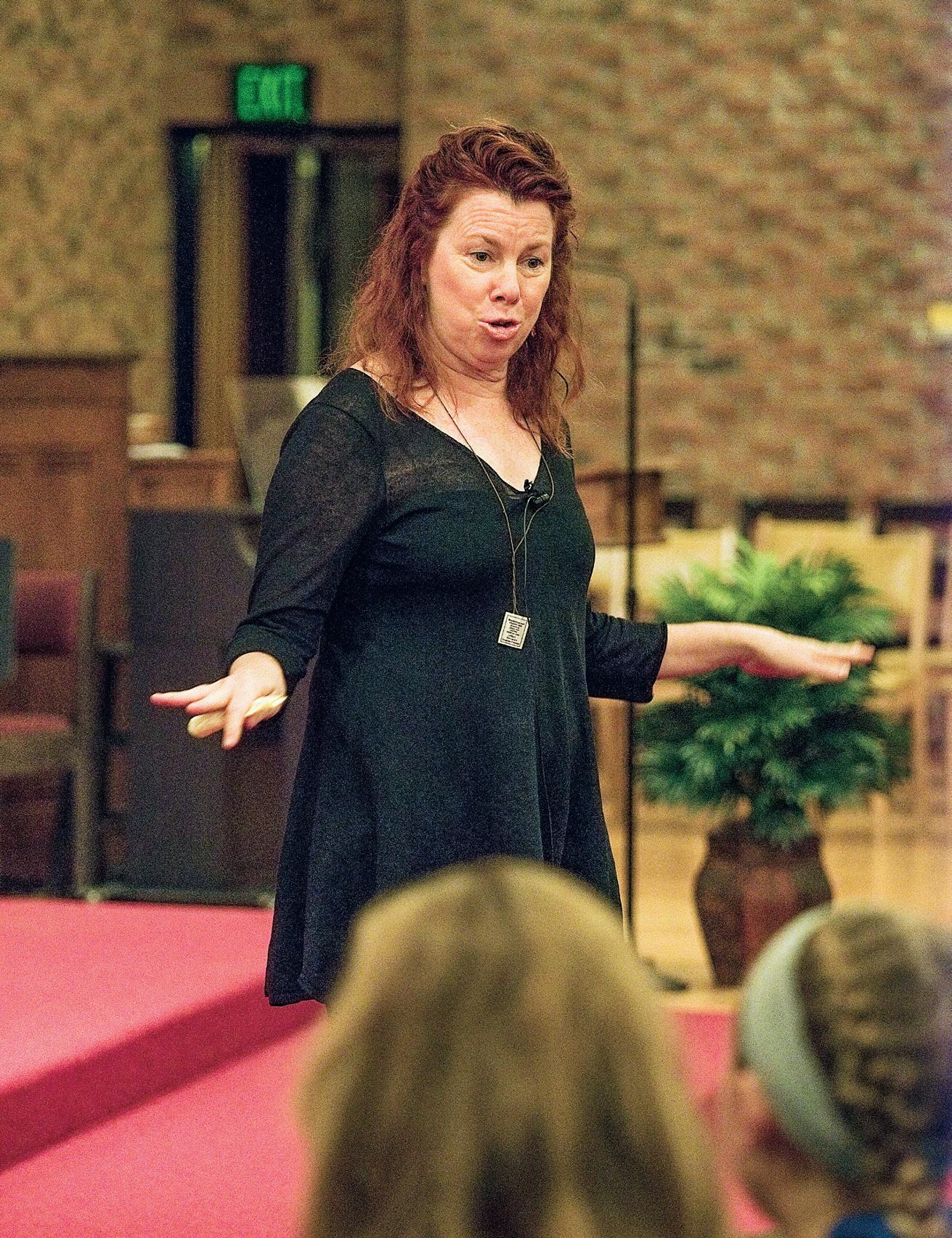

on the property today. The fields and farmland that separated most of the houses in the area when the Fallon family moved to Caz gradually filled with homes and necessitated a bigger church.
Siobhan eventually responded to Cazenovia’s growth with a larger personal presence among the faith community.
“Oddly enough, I started a Bible camp.”
Like many volunteers today, she got involved as her own children — Bernadette, Peter, and Sinead — came of age as kids to attend and participate.
“When [the] kids were growing up, I would do the introduction of Bible camp and do all these skits with the kids and get the kids to kind of act out Bible stories.”
As sometimes happens, kids grow out of the campstage of life and parents and volunteers naturally lose interest as a result. The annual parish camp was eventually shuttered about 15 years ago. And as often happens, it took a startling, tragic moment to get back to focusing on good things like summer Bible camp again. The 2022 mass school shooting in Uvalde, Texas, was Siobhan's catalyst.
“When I heard about the terrible tragedy in Texas, I was like, this is terrible. And kids are all screwed up with too many phones and too much internet. No one’s focusing on faith anymore.”
So, she approached Father Kevin Corcoran, pastor of St. James, to profess her desire to restart the summer camp, in spite of the fact that it had been some years since her original effort.
“I know I’m no spring chicken anymore,” she told us. “I basically rally the troops.” Siobhan announced the plans at weekend Masses. Her team consisted primarily of parishioner/volunteer Mary Beth Kuhn and Siobhan’s sister Megan, whom Siobhan refers to as “the brains behind the operation,” paying homage to Megan’s master’s degree in theology. She earned the degree while working full-time as an attorney in the Syracuse area.
“We’re a great team,” Siobhan said. “Mary Beth knew all fun things for kids like the arts and crafts. And I would get the kids going and act it out. So, it would
I always say, I don’t know
why people care about celebrities, because
people shouldn’t think they are so much more important.

sure there was a Catholic church nearby and that we continued to try to educate them as best we could in the faith.”
Her own experience growing up in the faith was amazing, she said. As many likely remember, faith formation was once referred to as CCD or the Confraternity of Christian Doctrine.
SIOBHAN FALLON-HOGAN
become really interactive.” Their timing was perfect. “It got the kids back in church after COVID and especially made it come alive again.”
starts at home
Making time for the Bible school kids is an outgrowth of raising her own three children, not an easy reach for someone balancing a busy career.
“I made sure that my kids came first. And I made sure that I would work them, literally — contractually — into my different jobs.”
For example, an extended project in Denmark required housing for her family as well as a babysitter. Sunday Mass attendance was a must, as well as Sunday school-like projects Siobhan recalled from her own youth.
“I remember being in the house and making relief maps of Israel,” she laughed, “and we’d have Sunday school, wherever I was.”
Her work has taken her and her family literally around the world, even to a small community in the bush country of Australia where they celebrated a special Easter Sunday.
“They had a procession for Easter, carrying in the cross. It was great for the kids. They went to Catholic school, which was amazing.”
The experience taught her children valuable life lessons, appreciating — even at a very young age — the vulnerability and feelings of others they met.
“‘Don’t give us cookies in our lunch anymore,’” her children told her, “‘because we don’t want kids to think we’re rich.’”
She added that “it was great for the kids to see, traveling like that. So, wherever we went we made
“It was such a part of the community that you would leave school … and you would actually be bused to the [church] school in the middle of the day and then go back to school. It was like ‘there go all the Catholics!’”
Her own faith was influenced by her pastor, Father A. Robert Casey, “a great priest,” as well as parents and volunteers who “came together to teach the faith.”
Cazenovia is now primarily a summer destination for the Fallon-Hogan family; they spend most of their time at their New Jersey home where Siobhan’s faith life thrives as well. She has participated in weekly Rosary groups in addition to regular worship attendance. Her own children went to Catholic schools in the area including a daughter who attended Marist, the Catholic college in Poughkeepsie.
Siobhan is, obviously, a celebrity, but a conversation with her is much more like a chat with a neighbor or, in the case of this audience, a fellow parishioner.
“I always say, I don’t know why people care about celebrities, because people shouldn’t think they are so much more important.” But the one great thing about fame is the empowerment it can carry to bring attention to a cause. And to Siobhan, living her faith in practical situations is a very big cause.
“For example, when my son was in high school, I had a problem with the material they were reading because I thought it was filthy.” Being a person who is “not afraid to say what I think,” she reached out via an email group to other parents to be sure they were aware of the material. About 320 people signed a petition calling for change. “When I do things it’s go big or go home” she shared. And that’s where being a well-known personality can make a social difference.
“When I went after the school, they thought I was just going to be, you know, a small voice. And when
we showed up with TV, newspapers … (laughter) … I don’t do things small, and I get people behind me.”
Siobhan has done one-woman shows, theater roles, and has portrayed characters in a long list of film and TV credits, but only accepts roles and writes material that align with her personal beliefs, especially her Catholic faith.
Nowhere is that more evident than in a couple of her more recent projects.
Shelter in Solitude is “a brilliant story of a man on death row,” according to Writers Guild of America president David Goodman. What it truly is, according to Siobhan, is “a Catholic, a woman who is unconventional. She’s a country singer and she owns a bar.” As the writer and star of the film, it all happened at a crossroads moment in her life.
“So, over the years, I always did one-person shows. And when my youngest daughter, Sinead, was a junior in high school, and she was going to go off to college, I thought, ‘Oh, my gosh, I’m not domestic, I really can’t cook. What am I gonna do now?’ So, I thought, “‘Well, let me take a stab at writing a movie.’”
Without spoiling the plot, Siobhan’s deep Catholic values come through in Shelter as well as in Rushed, the story of an Irish Catholic mom who loses her son in a tragic, avoidable hazing incident as a college freshman.
“The Rosary is in both of my films. Because, you know, it’s important to the characters, and the faith is very evident in both films.”
How does one make that happen in a media world that so often produces content so contrary to faith and Christian culture? It’s simple: Take charge. Assume the roles of producer, writer, and star of the projects, surround yourself with people you trust, and go forth.
“It’s great to be the boss, because you can do whatever you want, you can put in whatever you want, and you can run the show the way you want to.”
In her words, Rushed was a project she approached with a certain innocence — “blindly and naively” as a
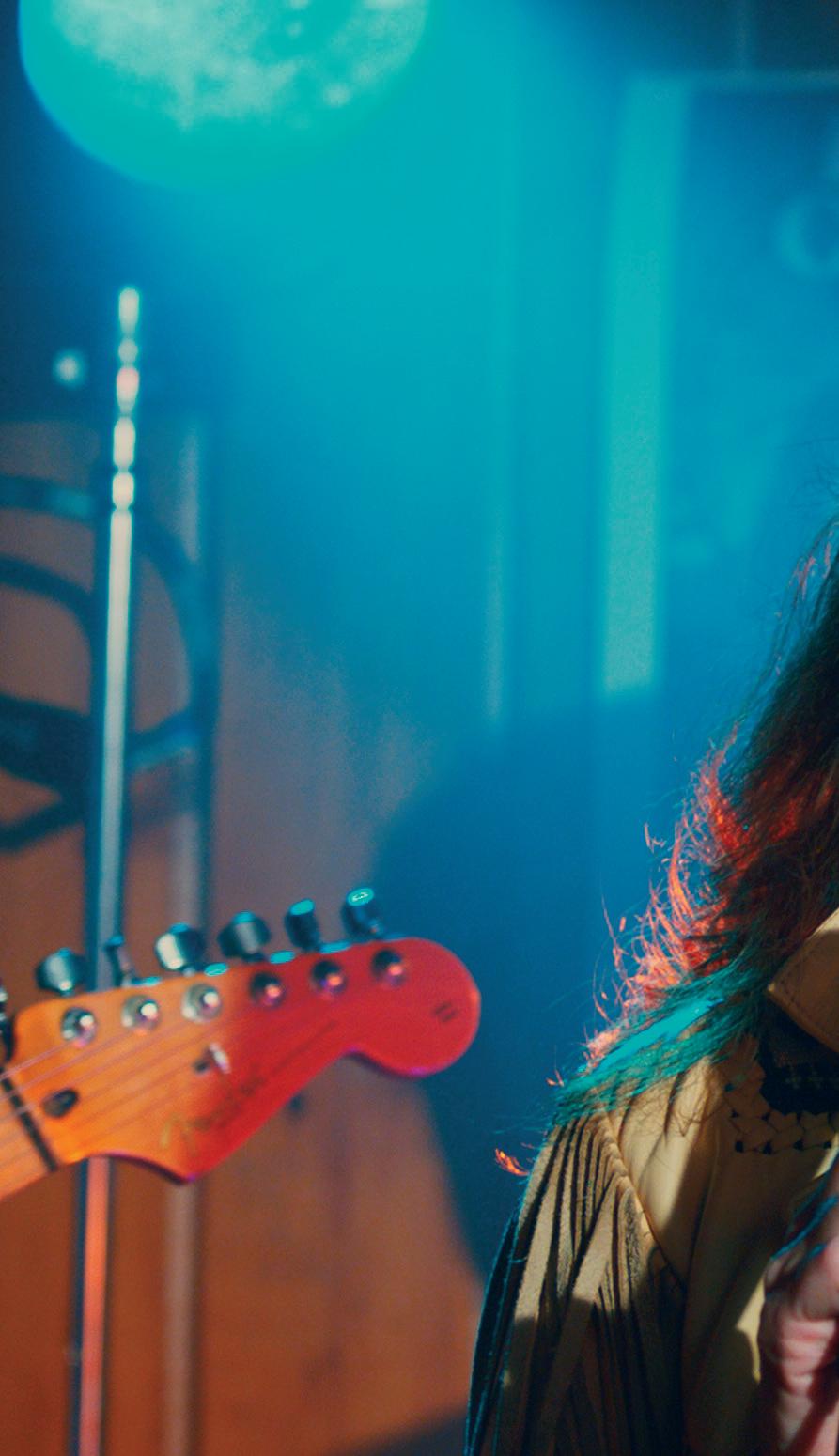
In one of her most recent films that she wrote, Shelter in Solitude, Siobhan Fallon-Hogan also plays the main character, an unconventional Catholic woman who is a singer and bar owner. Fallon-Hogan’s deep Catholic values come through in this film.
writer and producer — but the experience prepared her for Shelter in Solitude.
“I knew what I was up against. I was like, ‘Whoa, this is really hard.’ I explain it to people … it’s like having a wedding every single day.”
The film is shot, goes through post-production, and then the producer/writer/cheerleader has to sell it for distribution and support. She matches the investment the buyer makes with a personal investment in prayer.
“I don’t want to let them down. So, literally, I’d go to daily Mass and be like, ‘Okay, listen, you gotta help me out, because this is getting pretty scary.’ So, I would just pray my rear end off for success. And things would happen.”
Everything from good filming weather to a Nashville songwriter donating two songs for the score just seemed to flow.
“And you feel like you’re surrounded by angels. You’re surrounded by God just leading you the whole way. Because I’m like, ‘God, here’s the deal. I promise you I will

spread your word with my films. Please help me out.’ It’s my constant prayer.”
With deep CNY roots, an extended family that continues to stick together (with an annual reunion at an uncle’s Skaneateles camp, for example), and influences like her aunt, the late local theater producer Sheila Shattuck, Siobhan’s strong foundation in faith and family sustain her and set the stage for continued blessings at home and career.
“I say to my kids, ‘Look, this is where your happiness is going to come from.’ Just make it a daily part of your life.”
Fallon-Hogan currently has four projects in various stages of production: Memory Motel, All Choked Up (short), One of Us, and One Stupid Thing
Her list of film and television credits is extensive and impressive: Taxon (2024)
The Zombie Wedding (2023)
Shelter in Solitude (2023) Eileen (2023)
Wasted Blind (2022)
Clifford the Big Red Dog (2021)
Rushed (2021)
Love Life (2020)
The Shed (2019)
Yes (2019)
What We Do in the Shadows (2019)
Dark/Web (2019)
The Professor (2018)
Elementary (2012)
The House That Jack Built (2018) Billions (2016)
Private Life (2018)
It Makes A Sound (2017)
Weightless (2017)
Going in Style (2017)
American Gods (2017)
MacGyver (2016)
Scorpion (2014)
Wayward Pines (2015)
All We Had (2016)
Conundrums (2016)
Fred: The Show (2012)
Fred 3: Camp Fred (2012)

Someday This Pain Will Be Useful to You (2011)
Fred 2: Night of the Living Fred (2011)
We Need to Talk About Kevin (2011)
Another Happy Day (2011)
The Whole Truth (2010)
Fred: The Movie (2010)
The Secret Friend (2010)
Sonny with a Chance (2009)
The Bounty Hunter (2010)
New in Town (2009)
Baby Mama (2008)
Funny Games (2007)
30 Rock (2006)
Charlotte’s Web (2006)
I’ll Believe You (2006)
Fever Pitch (2005)
Rescue Me (2004)
Dogville (2003)
Law & Order: Special Victims Unit (1999)
Daddy Day Care (2003)
Holes (2003)
Big Trouble (2002)
Rain (2001)
What’s the Worst That Could Happen? (2001)
Third Watch (2000)
Dancer in the Dark (2000)
The Photographer (2000)
Boiler Room (2000)
The Negotiator (1998)
A Cool, Dry Place (1998)
Krippendorf’s Tribe (1998)
Men in Black (1997)
Feds (1997)
Fools Rush In (1997)
Nick and Jane (1997)
Good Money (1996)
Striptease (1996)
Jury Duty (1995)
Only You (1994)
Forrest Gump (1994)
The Paper (1994)
Greedy (1994)
Seinfeld (1991-1994)
Saturday Night Live (1975)
Schiller’s Reel: Million Dollar Zombie (1992)
Baby Talk (1991)
Adventures in Romance (1991)
Haywire (1990)
Babes (1990)
The Golden Girls (1985)
The Unnaturals (1989)
By Eileen Jevis
The student, as they say, has now become the master. Allyson Headd ’08, returned to Bishop Grimes School as its principal in 2020 and has been implementing physical and technological changes to increase the school’s competitive advantage.
After high school, Headd moved to Indiana and earned a bachelor’s in secondary education from Saint Mary’s College and a master’s in educational leadership and administration from Ball State University. Upon graduation, she worked at a Catholic high school in the Midwest as a teacher and coach before taking over as vice principal and director of curriculum and technology. After five years, she was appointed principal and CFO.
Education has changed significantly since Headd was a student at Holy Cross and Bishop Grimes schools in the Syracuse diocese. Although the emphasis has always been on providing a high-quality, student-centered, faith-based education that shapes well-rounded individuals and welcomes students of all races, religions, and economic backgrounds, Headd noted that during her time in high school, the approach was focused on fitting all students into one lane, she said. “Now we like to focus our attention on how classrooms can provide differentiation for each individual student.” One thing that has remained, especially in Catholic schools, is the commitment to excellence by teachers and staff and the feeling of family in our school community, Headd emphasized.
Her professional experience includes representing her former school’s international program. Headd traveled to partner schools in Italy, France, Spain, and China to establish relationships, teach, and collaborate with school administrators. “The partnerships and inspiration I gained traveling throughout Europe, China, and Africa provided me with a broader knowledge and understanding of global education,” she said. Additionally, she was instrumental in implementing the Apple technology initiative, which she also brought to Bishop Grimes shortly after her arrival. “Our partnership with Apple technology gave us the ability to use it beyond supplementing textbooks,” Headd shared. “Due to the remote-learning needs during the pandemic, many schools handed out technology to their students and staff. But it is how that technology is being used to transform and empower students that is our focus going forward.”
Every student has an iPad and every teacher has an iPad Pro. Each classroom is equipped with a television, and the library and computer lab were renovated and reopened as the Nancy J. Toscano Learning Center, which consists of the main library, a senior lounge, and a learning lab. One of the many upgrades is the cuttingedge technology that further accentuates the new 1:1 Apple platform. This enhanced technology will ensure that students keep up with college requirements to be competitive in a global economy.
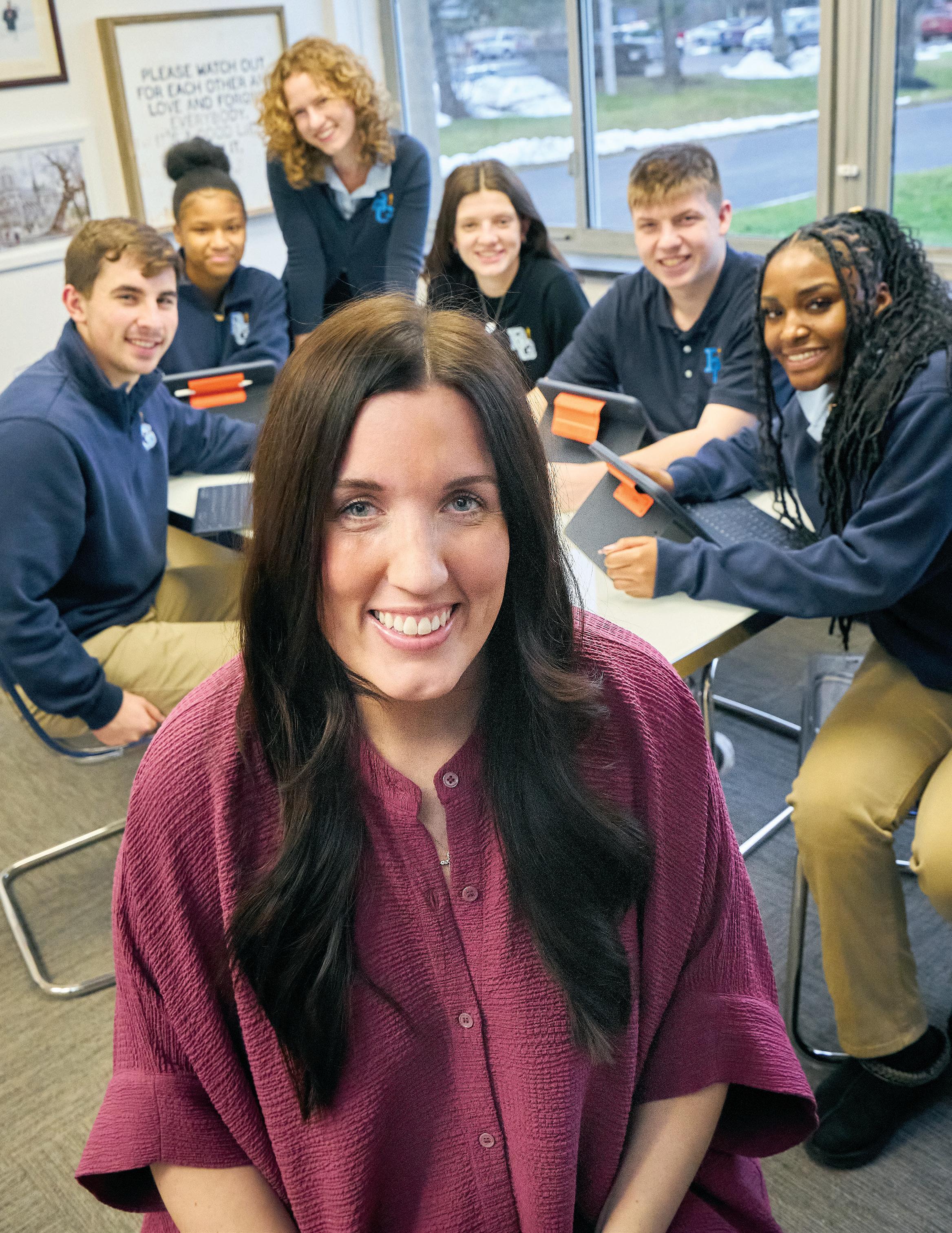
Grimes has a partnership with Apple — each student is equipped with an iPad and each teacher has an iPad Pro. Principal Allyson Headd said this Apple 1:1 platform allows the ability to use technology “beyond supplementing textbooks.”

When Assistant Principal Pat Kinne sat down with Headd on her first day, he developed a strong sense of her leadership abilities. Since then, he has been reminded every day of her devotion to her faith and her fierce passion for her alma mater. “She had new and lofty goals,” he said. “Her plan for the school was multilayered and comprehensive. In truth, it seemed rather daunting,” said Kinne. “It has been hard work, but it’s truly satisfying and fulfilling to see the positive changes that have taken place. I am truly thankful to be able to work alongside Allyson and help shape Bishop Grimes into the school I always knew it could be.”
Alumnus and board member Charles Falgiatano ’90 was also impressed with Headd during the interview process. “One of the things that stood out with Allyson was her commitment to her Catholic faith and her short-term and long-term visions for the school,” he said. “Allyson has a great ability to connect with people of all ages, backgrounds, and walks of life. Her goal was to not only learn the names of the students
As a high school studentathlete, Headd was described by her former coach John Cifonelli as “the student others would turn to when they had a problem.”
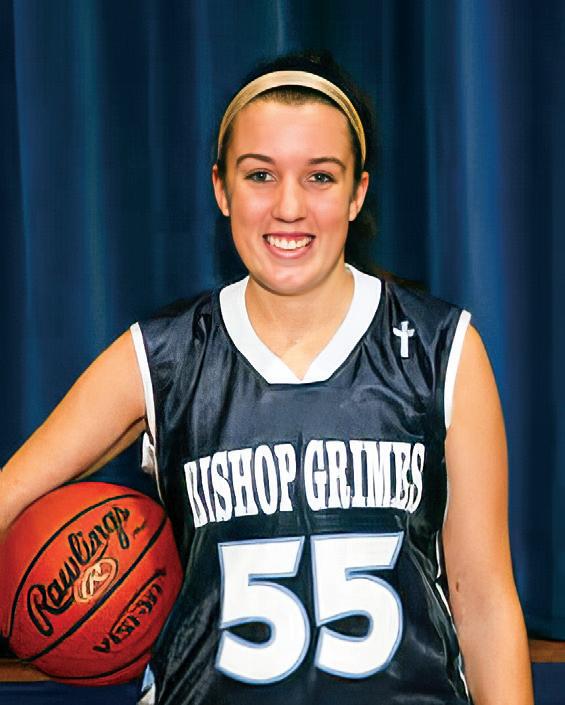
“Allyson
has a great ability to connect with people of all ages, backgrounds, and walks of life. Her goal was to not only learn the names of the students and staff but make a connection with each of them. That is the sign of a great leader.”
CHARLES
FALGIATANO ’90
and staff but make a connection with each of them. That is the sign of a great leader.”
In addition to preserving the traditions at Bishop Grimes, Headd will continue to upgrade the school to prepare students for success in college and in life. With a 100 percent graduation rate, she and her team will focus on educating the whole student using the school’s founding principles of faith formation, academic excellence, and service to others.
“There is no greater investment than education, especially a quality one,” Headd said. “To be able to be involved in the decision making and have the opportunity every day to impact a life is a privilege. I’m extremely fortunate to have been a product of the Catholic schools in the diocese and it is an honor to now serve here.”


To be able to be involved in the decision making and have the opportunity every day to impact a life is a privilege. I’m extremely fortunate to have been a product of the Catholic schools in the diocese and it is an honor to now serve here.
ALLYSON HEADD ’08
BY EILEEN JEVIS
“Each of you should use whatever gift you have received to serve others, as faithful stewards of God’s grace in its various forms.” 1 Peter 4:10
Sometimes, events in our lives cause us to reevaluate our current paths.
For Mark and Nina Ranieri, the death of Nina’s father from COVID-19 was a major factor that led the couple to reexamine their lives. With Nina by his side and as caregiver and nurturer to their children as a stay-at-home mom, Mark resigned his position as principal in the Oriskany Central School District. The couple sold their house and the family moved to Sherrill to join the Spirit of Hope Catholic Community where Mark is now the youth minister for the six parishes in Canastota, Verona Beach, Oneida, Sherrill, and Vernon.
The Ranieri family’s strong faith has
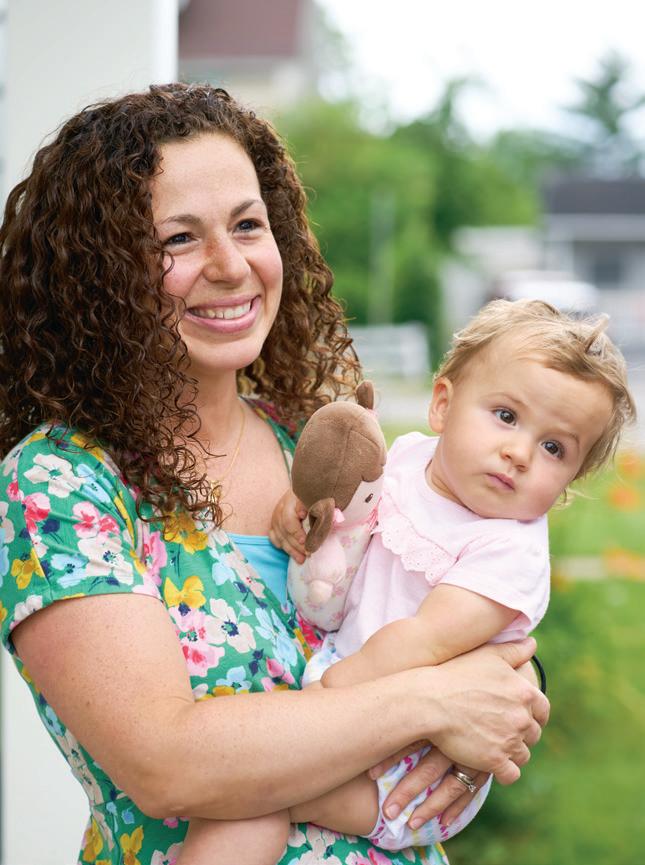
guided Mark and his siblings since childhood and influenced their career choices, vocations and desire to help others. Mark earned a bachelor’s degree from SUNY Geneseo, a master’s from Le Moyne College and a master’s/certificate of advanced study from SUNY Stony Brook. He previously served as the youth minister at Holy Family Church in Syracuse and Our Lady of Lourdes Church (now Mary, Mother of Our Savior) in Utica.
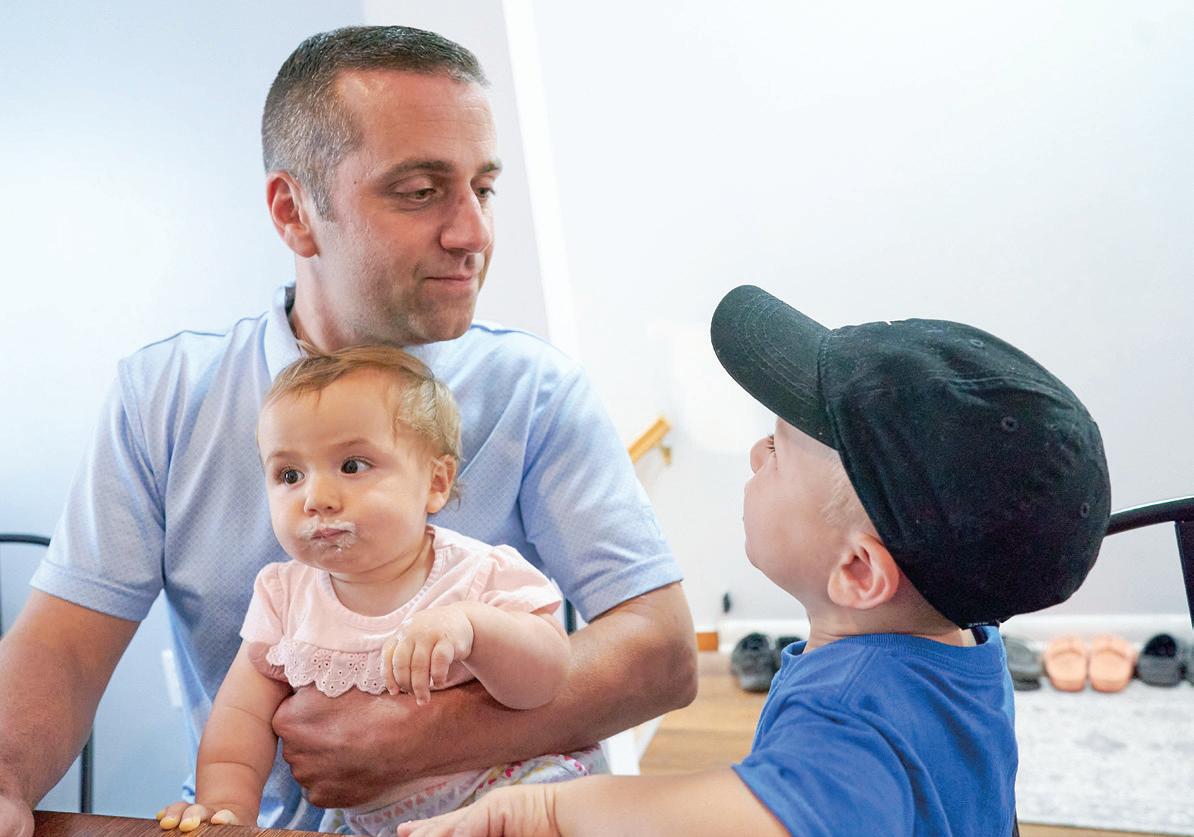
After receiving a bachelor’s degree in elementary and special education from SUNY Geneseo, Nina earned a master’s in literacy from SUNY Cortland. She taught special education and reading for three years before becoming the faith formation coordinator at Our Lady of Lourdes. She then accepted the role of natural family planning coordinator for the Family/Respect Life Office for the Syracuse diocese. Her most important job to date, she said, is being a mom to their seven children.
After working for over a decade as an administrator in education, Mark said he felt called to return to youth ministry to have more direct contact with students and their parents.
“Although there is a lot of overlap in being a teacher and an administrator, God was calling me back to work for the church in a strong way. To borrow the words of St. Mother Teresa of Calcutta, God gave me a ‘call within a call,’” Mark said. “My primary
“The
whole thing was a leap of faith. The decrease in salary and leaving behind health insurance caused us to really question what we were doing. Sometimes, we look back and laugh because you can forget that God’s hands are in all of it. If He wills us to do this, He’s going to take care of these little details.”
—NINA RANIERI
vocation is as a husband and father. Yet at the same time, God called me back to serve in the vineyard of His church as a youth minister.”
While perusing the www.catholicjobs.com website, Mark read that Father Richard Prior, his former pastor at Holy Family Church, was looking for a youth minister at Sacred Heart in Cicero. He called Fr. Prior and said, “Is it crazy if I asked to be your youth minister again?” During the following weeks, the pair had multiple conversations focused on Mark’s career change and the hope that Fr. Prior could find a house for him and his family. However, they couldn’t make it work.
“At the same time,” Mark explained, “this other thing happened. On New Year’s Eve, I found out that Father Chris Ballard was looking for a youth minister for the newly merged parishes in Oneida and Madison counties.”
After much discussion with Fr. Ballard, the Ranieris decided what to do based on two main factors — it wasn’t far from their current home and there were two vacant rectories they could renovate and make their own.
“The whole thing was a leap of faith,” Nina said. “The decrease in salary and leaving behind health insurance caused us to really question what we were doing. Sometimes, we look back and laugh because you can forget that God’s hands are in all of it. If He wills us to do this, He’s going to take care of these little details.”
There’s been a lot of transition and there is fear when things get stormy, Mark said. He called to mind Matthew 8:23-27: Jesus and His disciples get into a boat and begin to cross a lake when a storm suddenly arises. Jesus is

asleep while the waves crash into the boat, and His disciples wake him up in fear, saying, “Lord, save us! We are going to drown!” Jesus replies, “You of little faith, why are you so afraid?” He then gets up, rebukes the wind and waves, and the storm is immediately calmed.
“There’s a lot of moments like that,” added Nina. “They happen late at night after a long day. You want to cling to what you know because all the unknowns can be frightening. But we have to trust ourselves and trust that God knows what is best for us.”
The couple’s transition back to youth ministry included purchasing and renovating St. Helena’s rectory, which is next door to their home and geographically located at the center of the Spirit of Hope Community. Nina compares home renovations with the work that God is doing with their souls. “There is a lot of tearing down walls. I think that everyone builds up walls for whatever reason — whether trauma or wounds ...”
Whether it be poor wiring, plumbing issues, delays in construction, or other challenges, the couple said that the tearing down and rebuilding is an “in your face” reminder of what God is doing to them inside and out. “We are a work in progress just like this house,” said Nina. “It’s definitely been a journey. And it’s not over yet.”
BY TAMI S. SCOTT
“For so many if not all of you here today, who were either on Mission 20 or in the audience from the Vietnam era, you probably never thought you would experience the ideal I just shared. Walking down the hall from the gate after a flight, you returned to a much different reception. One best not remembered. Yes, it has taken decades to get us to this moment. But on behalf of Honor Flight Syracuse and me personally, it is our intent for this scene and the memories of today to replace those of yesteryear. And in so doing, let me and everyone here say to you two words you have been waiting a lifetime to hear: Welcome home.”
— RETIRED CAPTAIN CHRIS FLAHERTY, U.S. NAVY, UPON RETURN FROM HONOR FLIGHT MISSION 20
James “Jimi” Prettyman is a U.S. Army veteran soldier of the Vietnam War. His wife, Pat, served in the Army during the same era. In May of this year, the two were among 86 Central New York veterans selected to participate in Honor Flight Syracuse Mission 20. And it was an experience they’ll never forget.
“I was just amazed at how wonderful it was. I mean, everything clicked,” said Jimi, who was initially apprehensive about going. “There was no dull time, there was no downtime. Everything just went very smoothly.”
But it wasn’t so much the flight itself nor the day in D.C. as it was the welcome home that most touched the couple’s hearts.
“You get off that plane, you go down that ramp and everybody’s shaking your hands — everybody in the airport,” Pat shared with wonderment, describing the cast of thousands who gathered to greet them upon return: servicemembers in full uniform, members of motorcycle clubs, high school kids, and cheerleaders among all the families and friends. American flags waved in the air as the veterans passed through the hallways of Syracuse Hancock International Airport.
Syracuse diocesan priest Father Brendan Foley, among other pastoral duties, serves the Spanish Apostolate at St. Anthony of Padua in Syracuse. He stood in the crowd
to snap photos of Jimi, Pat, and their guardians Peg O’Hara and Patricia Blackman — all parishioners of St. Anthony — as they moved through the line.
Friends of the Prettymans who are Vietnamese also showed up, an unexpected blessing for Jimi. “That meant more to me than anything else,” he said, recalling conversations about their parents immigrating to the U.S. to flee communists.
Honor Flight also included a component called “mail call,” when the soldiers would receive letters from home every few days. Jimi and Pat received more than 100 letters on Mission 20 — from past and present parishioners of their church, high school seniors, and others they knew.
“It meant so much.” Jimi’s voice broke. “There were just so many good things that just swelled up in our hearts.”
The Vietnam War was a long, costly, and divisive battle that climaxed in the ’60s with the deployment of U.S. combat forces. It drew mass protests nationwide where thousands engaged in sit-ins, occupations, and blockades. Protesters resisted the draft and obstructed military operations, and as the war escalated, violence resulted. People opposed the war for various reasons: it lacked clear objectives, was
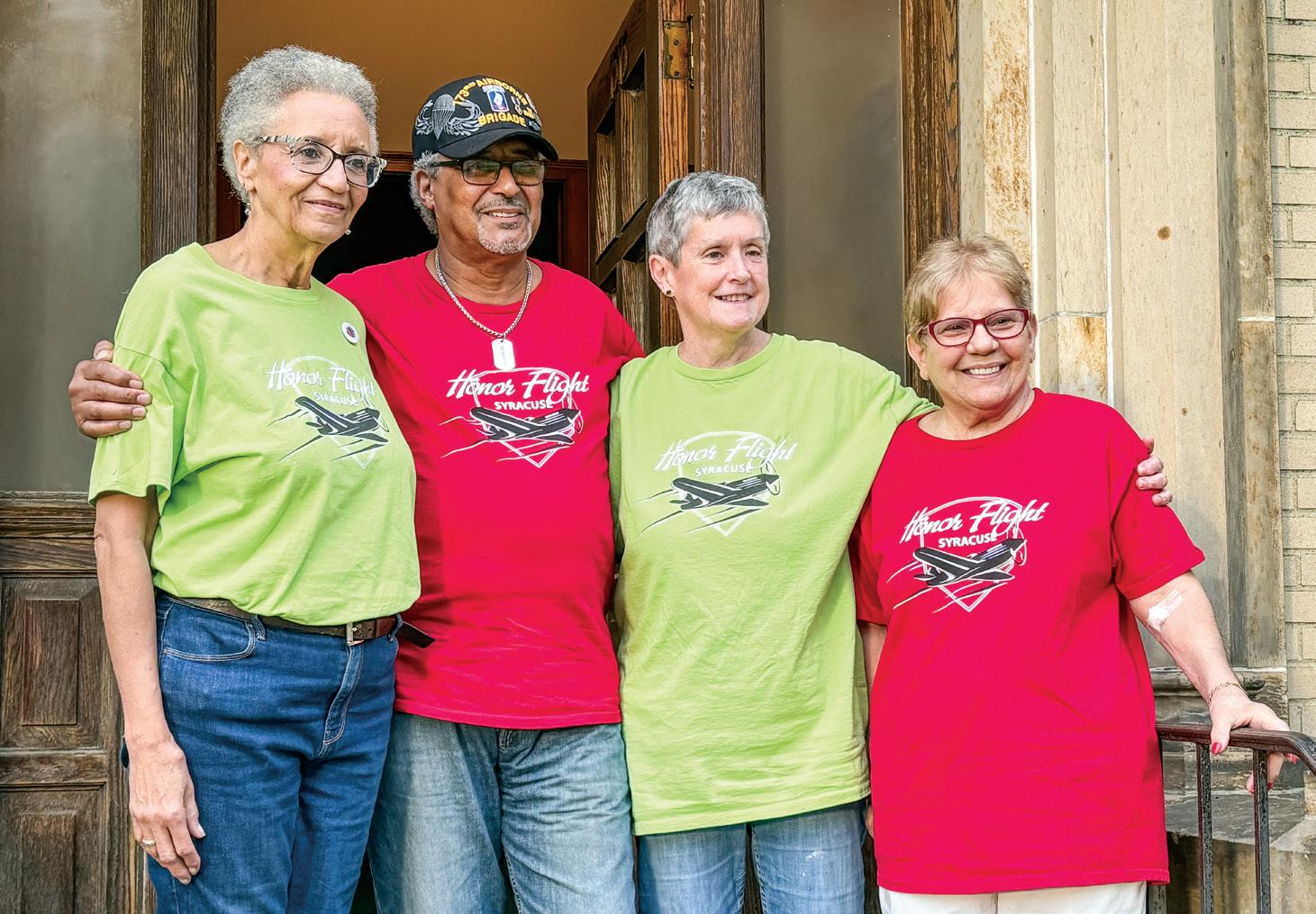
deemed unwinnable, or the U.S. had no right to intervene in what they believed was a foreign civil war.
In the end, more than 2.7 million young Americans were sent to defend South Vietnam from becoming a communist country and more than 58,000 of our own were killed in combat.
Jimi journeyed 8,000 miles to live on enemy ground for 12 grueling months, facing death daily in one of the most controversial battles in American history. His unit was assigned to the Central Highlands comprised of mountains and triple canopy jungle. The rugged terrain was notorious for making navigation brutal and the canopies were so dense they blocked sunlight, wind, and rain, and created intolerable heat in the day and frigid cold temps at night.
In contrast to the draft dodgers of the time, Jimi enlisted. Two close friends of his had dropped out of their last year of high school and joined the Army. Both were killed in combat and were ultimately the reasons Jimi stepped up. Gratefully, he made it back home, but it wasn’t to the same home he left. Rather, the troops were met with an unyielding hostility that endured long after the war ended.
Jimi shared his memory of the day they departed Vietnam. How, for the first 30 minutes, there was complete silence on the plane, all soldiers lost in thought until the pilot announced they were safe, out of the war zone and on their way home.
“Then the place erupted like a concert,” he said. “It was really loud and everybody was happy. And that lasted about half an hour. Then everybody went back into their own world.”
When they touched down in Seattle, they cheered again. They deplaned on the tarmac and “we all got down and kissed the ground, grateful to be back. It really felt good,” Jimi said. “And then it started.”
Finally, to be home, relieved, and believed to be on safe territory again, the soldiers weren’t warned of any subsequent struggles they’d still have yet to suffer — this time with fellow Americans. They were met with everything from dog feces and eggs to tomatoes. It appeared they never left enemy soil.
“We walked to the gate and there’s a huge crowd … and they peppered us with all kinds of items,” Jimi recalled. “It broke us down hard. That was our first experience of not being wanted, not being liked … feeling that we were not worthy.”
When they turned in their combat fatigues and were given new uniforms, they were told it would be for their benefit to change out and discard them before they left the airport.
Jimi, the man he was before the war, had also changed. He had developed post-traumatic stress disorder (PTSD) — a condition no one understood at the time. He thought several times of suicide.
“When I was here, I was still over there,” he said. “I was a mess.”
Pat enlisted in the Army in Pittsburgh before heading to Anniston, Alabama for basic training, then med school in Fort Sam Houston, Texas. She had volunteered to go to Vietnam but was refused due to the Sole Survivor Act — her brother was already there.
Instead, she was stationed in Fort Jackson, South Carolina, where she ran a pediatric clinic — and that’s where she met Jimi.
“He sent his troops on sick calls,” she said, laughing. “Here they come wanting to go to sick call. I said ‘Boys, you’re in the wrong place. This is the baby clinic.’” She asked who had sent them and when they told her it was Sergeant Prettyman, “I’ll take care of him!” Truer words have never been spoken.
The couple married while still in the Army, then remarried years later after Jimi converted to Catholicism. He was confirmed by Bishop Emeritus Robert J. Cunningham. The ceremony took place at St. Anthony of Padua, with Father Robert Chryst presiding.
More than once, Jimi referred to his wife as his “rock” and his “saving grace” as he dealt with his mental health challenges that stemmed from the war and post-war.
“That’s when the change came over [me],” Jimi said, referring to his time as a Catechumen in the RCIA program.
Jimi described himself as a “really bad, bad person” even having had trouble with the law. “I don’t want to say that I lost my faith. I just pushed it to the backburner … I didn’t feel good about myself.”
He described Pat again as his rock by putting up with and understanding him. In RCIA, he shared the heavy burdens he had carried since wartime, asking questions such as, “Is there anything such as true forgiveness?” “Can I wash the blood from my hands and soul?”
“And I didn’t believe it was possible. But one day, I felt completely washed,” he said. “And I [have] tried to walk the straight and narrow ever since. I think I’ve done a pretty good job. I’ve helped a lot of other people, too.”
Jimi recalled feeling bitter when watching servicemembers return from subsequent wars with pomp and circumstance. “They got off the airplanes and the bands are playing and children running up to their fathers and loved ones,” he said. “I never had that. None of the guys that I served with ever had that.”
Until 54 years later, thanks to Honor Flight’s 20th Mission.
“It was maybe long overdue, but it was welcomed. It was truly welcomed by me and made me feel really good about myself again,” he said. “It brought me closure.”
RESOURCE CENTER



our table at the October 26 Women’s Conference !
PREGNANT WOMEN and NEW MOMS Direct donations can be made to Birthright @ 346 N. Midler Avenue, Syracuse 13206 Go to: BirthrightSyr.org or Facebook and Instagram Thank you for supporting our walk with Moms in Need







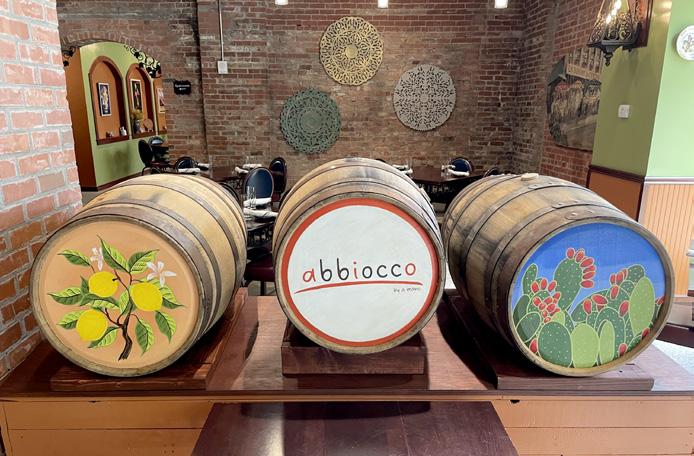

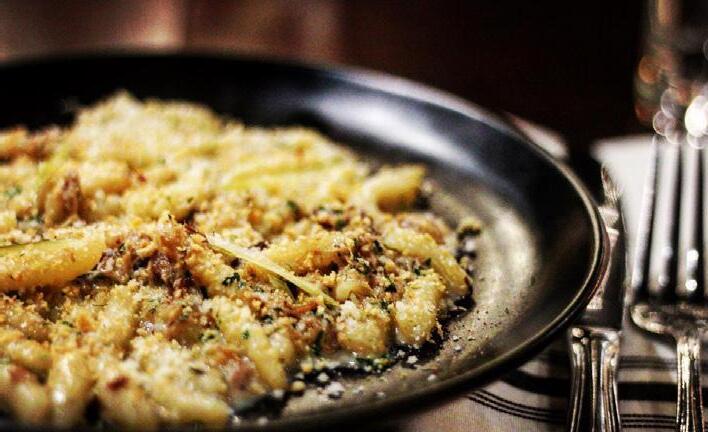

The next edition of SOLIS will warm up the winter … we invite your story ideas and suggestions to share with our readers. We are looking for unique events, unsung heroes and interesting tales of parish history and traditions. Contact us at solis@thecatholicsun.com or 315-422-8153







We o er rosary making and distribution, studies, monthly newsletter and weekly e-mailchimp, speakers, quiet prayer in our chapel with rst class relics. All are welcome to visit for private prayer or join in our schedule of prayer and studies.












BY DEACON DAN REYNOLDS
I’ve been thinking about humor and faith a lot over the last few years. As a professional humor greeting card cartoonist and Catholic deacon, I dwell at the corner of humor and faith. God has granted me the inspiration for my apostolate called the “Divine Comedy.” This evangelistic presentation marries faith and humor reminding people that joy — Christian Joy — is an indispensable part of strengthening faith.

A good laugh can make your faith feel stronger. It’s like a spiritual protein shake for the soul. Many of our Catholic saints demonstrated a sense of humor — St. Lawrence, for instance, cracking jokes while being grilled alive.
There’s St. Teresa of Ávila who fell off her horse, landed in the mud, and asked Jesus why this should happen to her as His faithful follower. She hears Jesus say, “This is how I treat my friends.” St. Teresa replied, “If this is how You treat your friends, it’s no wonder You have so few!”
We know God has a sense of humor, because Jesus is God incarnate. God took on human flesh. The shortest sentence in the Bible, ”Jesus wept.” (John 11:35) gives us a clue. If Jesus wept, so too must he have laughed. Jesus was like us in all things except for sin.
Lest you think I believe that life is just one laugh after another, let me assure you I don’t. There is pain and suffering. Many struggle to reconcile suffering with a good and loving God. The genesis of my call to the diaconate began not with a laugh, but with pain and suffering.
In the fall of 2008, at 48 years old, I was diagnosed with testicular cancer. Ironically, or providentially, my pain first came to me in the middle of Mass. I had to leave early, doubled over in pain. I knew something was seriously wrong so my wife took me to the emergency room. The pain became unbearable. It seemed like an eternity before I was seen by a doctor who gave me morphine, which barely helped.
After being examined and scanned, I was sent home with pain medication to await the results.
The day came for the diagnosis; my wife took the call. It was cancer. That day my life changed. I went to bed that night knowing I was on death’s doorstep.
Something happens at a moment like that. There’s only one place to look, and that’s up. So, look up I did, and I prayed. I prayed alongside the Lord in the Garden of Gethsemane because I was now in my own sorrowful garden. I repeated the words of Jesus, “My Father, if it is possible, let this cup pass from me; yet, not as I will, but as you will.”
At that very moment, my entire spirit lifted, and the weight of worry about death left me. From that moment on, it wasn’t a matter of was I going to die or not. I was transformed with a knowing assurance that God was with me and no matter what happened He would be by my side. From that time on, through months of surgeries and chemotherapy, and endless sleeplessness, I was a new man. I was broken physically, but spiritually reborn with God’s gift of humor fully intact.
I remember one day a nurse was wheeling me out of the operating room on a gurney toward the waiting room where my wife was praying and waiting. I looked up at the nurse as the gurney approached the waiting room and said, “Do me a favor. Pull the sheet over my head just before you wheel me in to see my wife,” I laughed. The nurse didn’t; instead, she hit me on the arm and said she would do no such thing. What she did do was immediately tell my wife, who did not appreciate my “gift!” I still think it would have been funny.
I didn’t realize it at the time, but my prayer with Jesus in the Garden the day I was diagnosed was the day the seed of faith was planted in me. God had dug in my soul a hole, a kenosis, a self-emptying of one’s own will in which I became entirely receptive to God and His divine will.
I took to prayer like a fish to water, and this water fed my prayer life.
My spirit blossomed I began to go to daily Mass which led to my serving as an acolyte. Next, I started helping out at our parish and was asked to work there part-time. I visited the sick, fed the hungry at a food pantry, led a weekly Bible group. Then one day, I was in the shower and something happened to me that words cannot describe. God’s spirit filled and overwhelmed me. I started to cry uncontrollably. I wasn’t hearing God’s voice telling me to become a deacon, but rather, I was being infused with the heart knowledge that this was His Will for me. I believe the overwhelming emotion I experienced was due to the awareness of my own unworthiness. This feeling abated when one day at the food pantry, a fellow volunteer said

Deacon Dan has traveled from his home state of New York to as far as Kansas and Montana to share his “Divine Comedy” presentation.
something to me I had never heard before, but since have never forgotten, “God does not call the qualified. He qualifies those He calls.” Wow! It hit home.
Being called was not about me. It was about what God wanted me to do. As Mother Teresa said, “I am just a pencil in God’s Hand, writing a love letter to the world.”
My point is God can use suffering to bring about the awareness of His love — and of his sense of humor.
As a Catholic deacon and cartoonist, I try to use God’s gifts of humor and art to win souls. This is my call within a call. Through the years, I have always incorporated religious cartoons in my work. Because of my conversion, I’ve been more focused on humor befitting the saintly than the secular. In my “Divine Comedy” presentation, I use G-rated jokes, saintly examples, plus my own religious cartoons to demonstrate how our faith life is enriched by humor.
I’ve traveled from my home state, New York, as far as Kansas and Montana to share “Divine Comedy.”
So, as we navigate this crazy world, remember to laugh a little, pray a lot, and find the humor in the divine comedy of life.
Father Seán P. O’Brien, pastor at St. Peter’s in Rome, and his 9-year-old Weimaraner, Franz-Josef, enjoy the outside sights together.
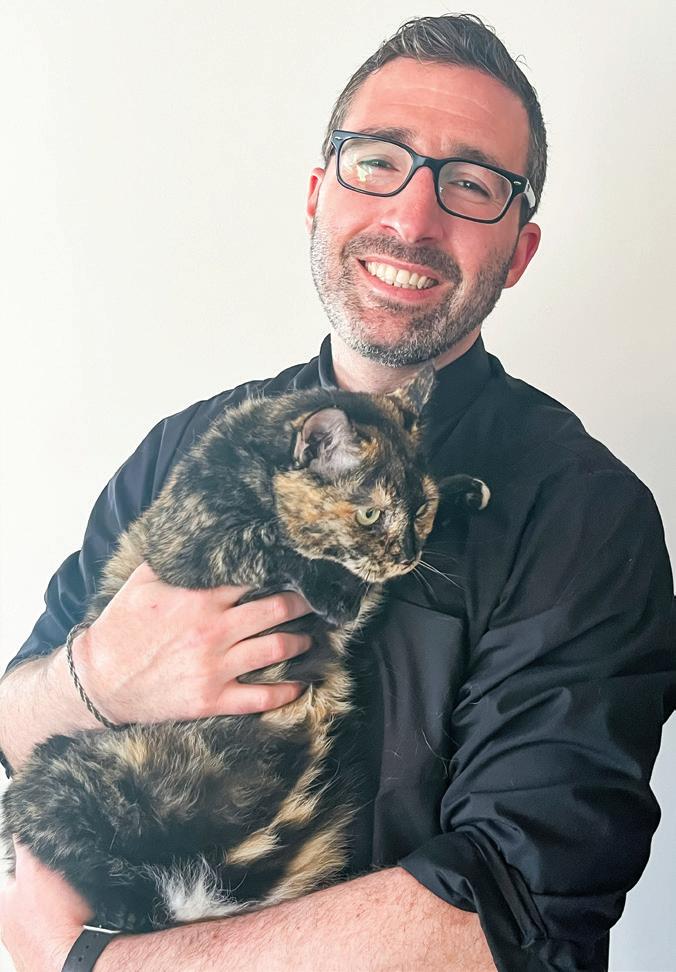
Fr. Jason Hage is pictured here with his cat, Gracie. Father is the pastor of Mary, Mother of Our Savior Parish in Utica. He is also the diocesan director of Vocation Formation.


Dan Muscalino, pastor of St. Francis Xavier Church in Marcellus, gets a hug from his dog, Honey.










